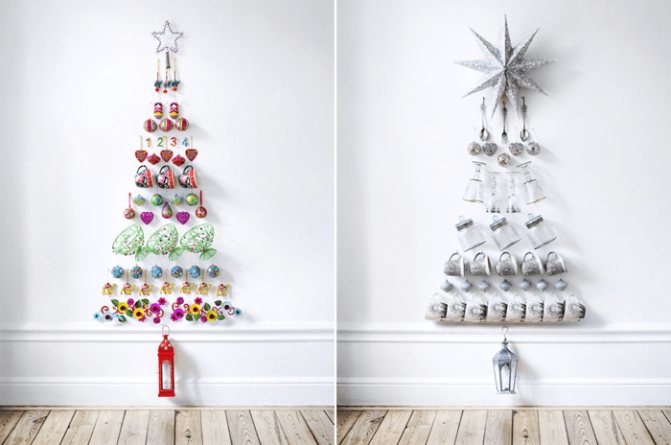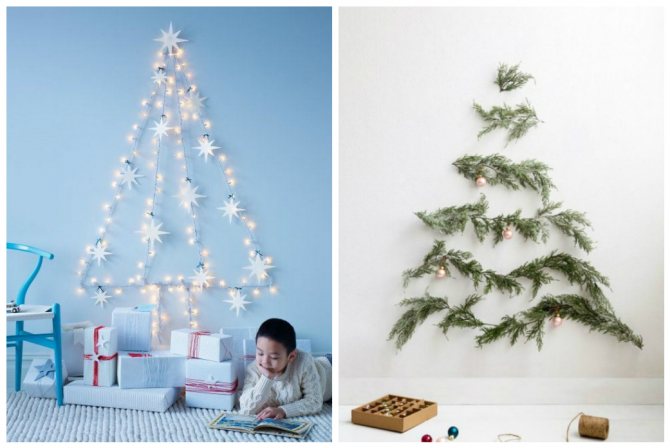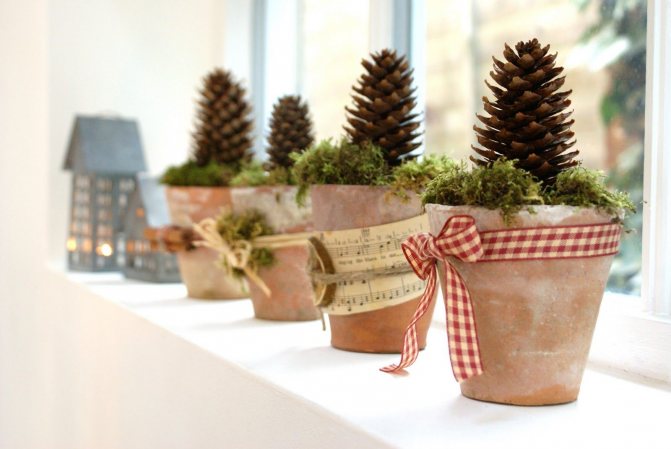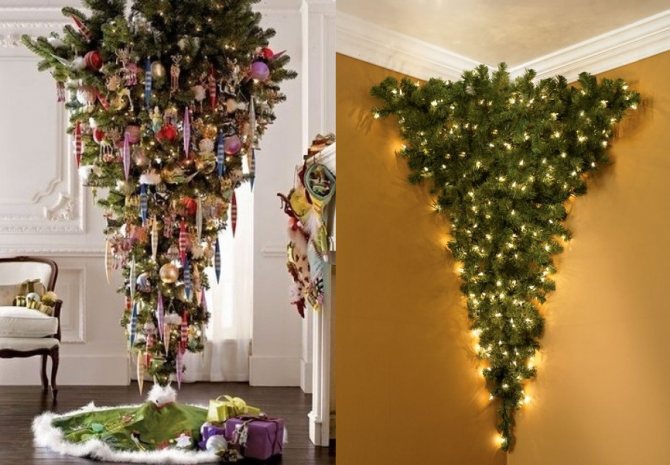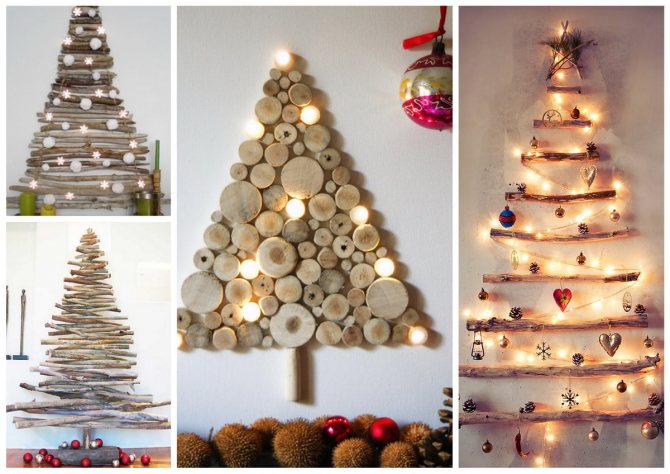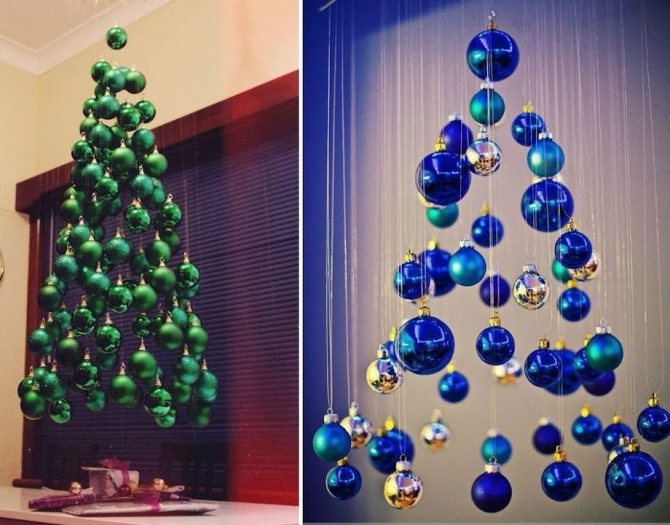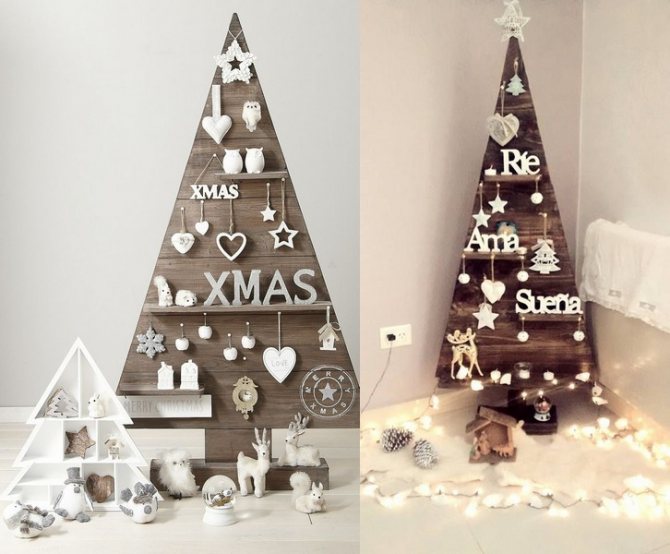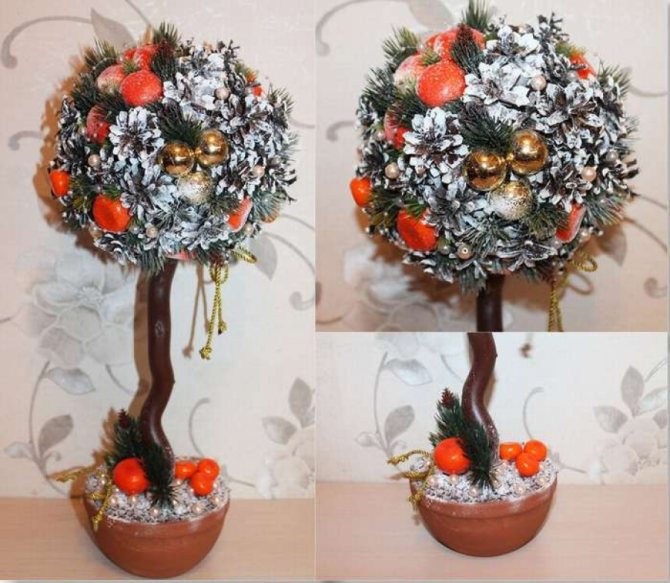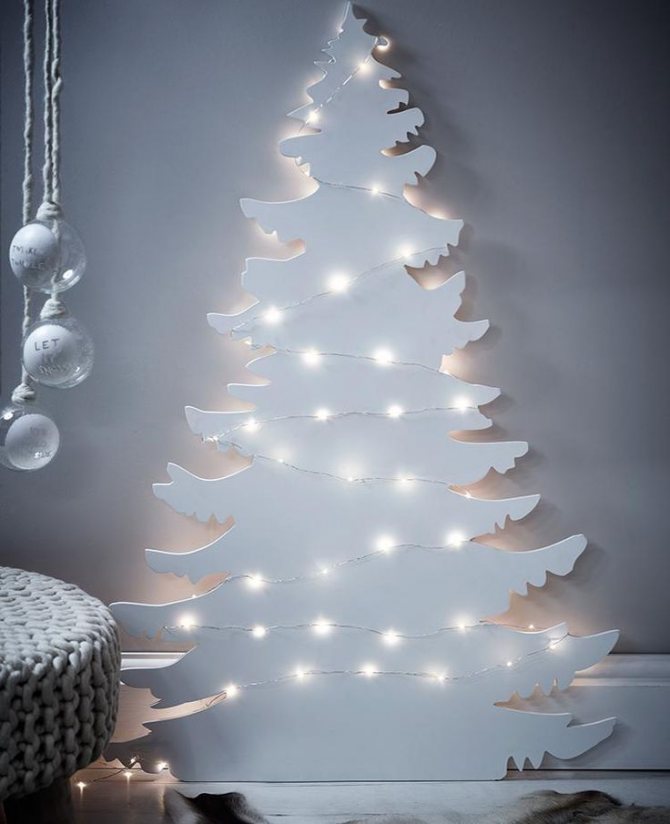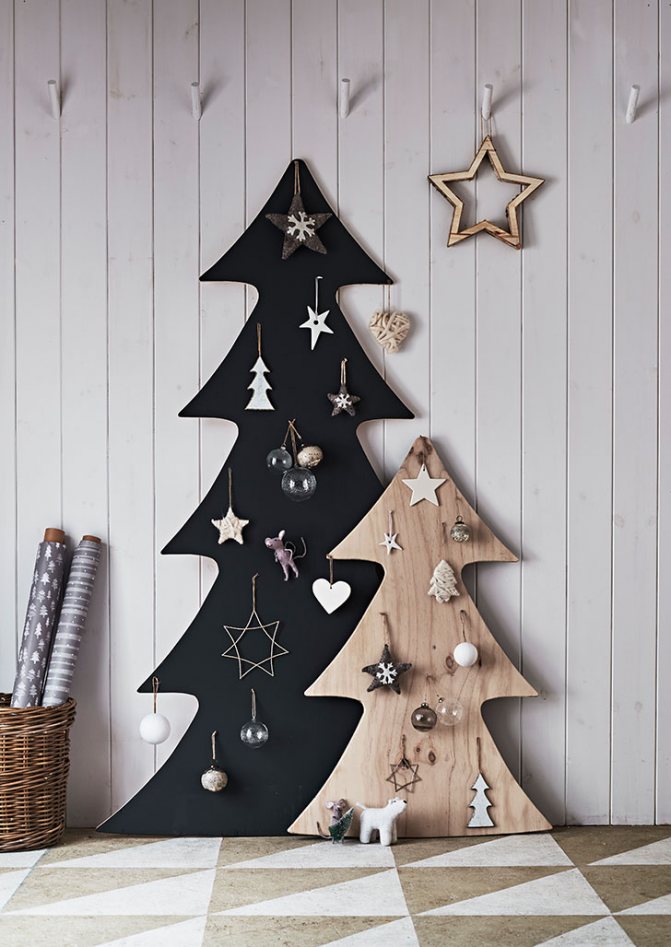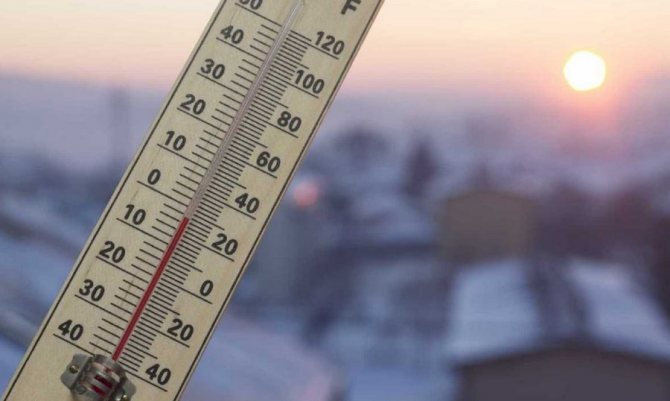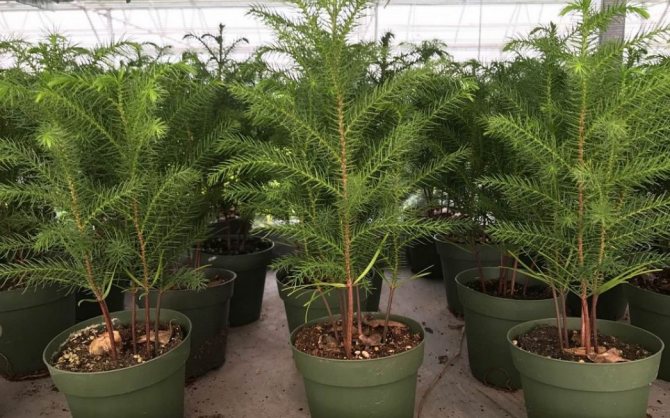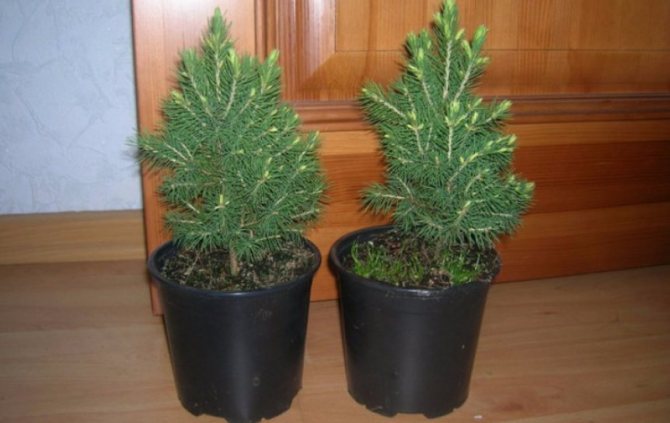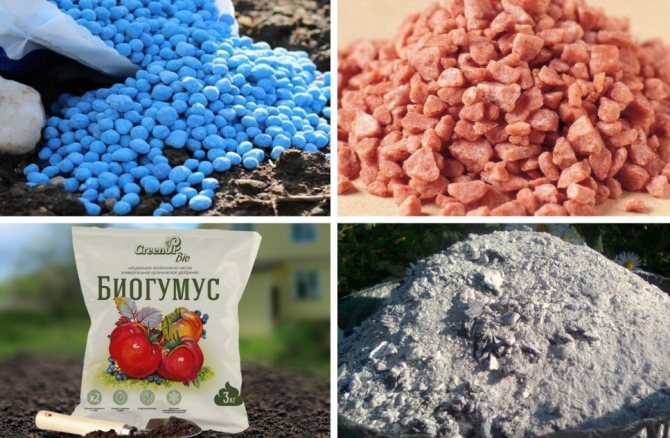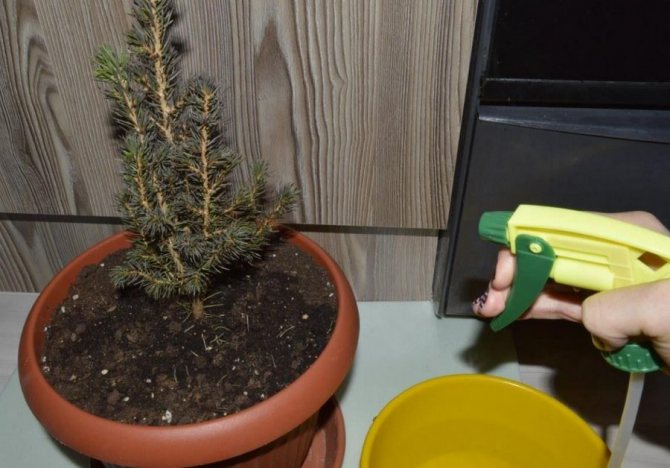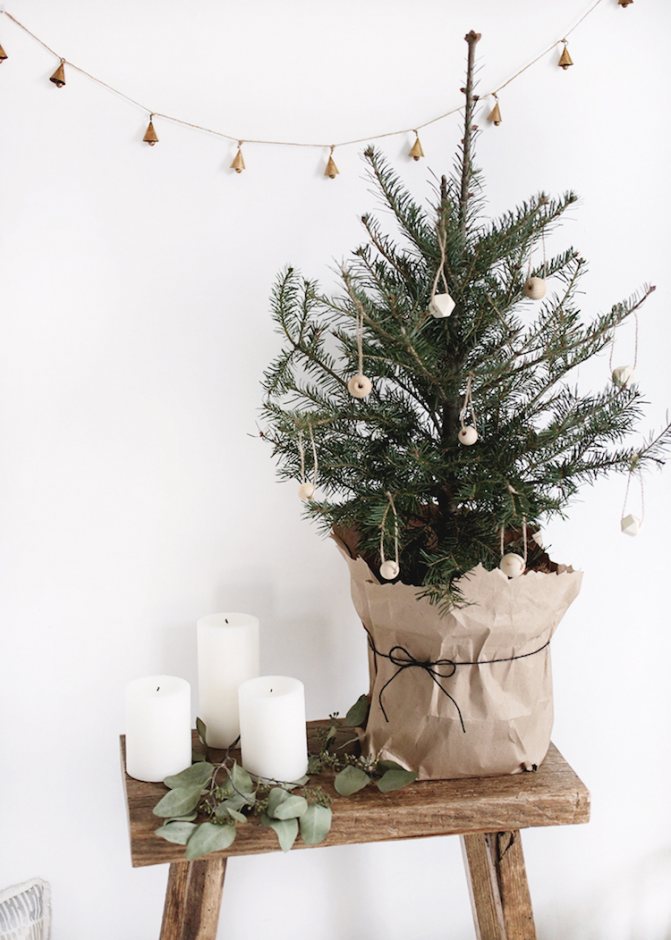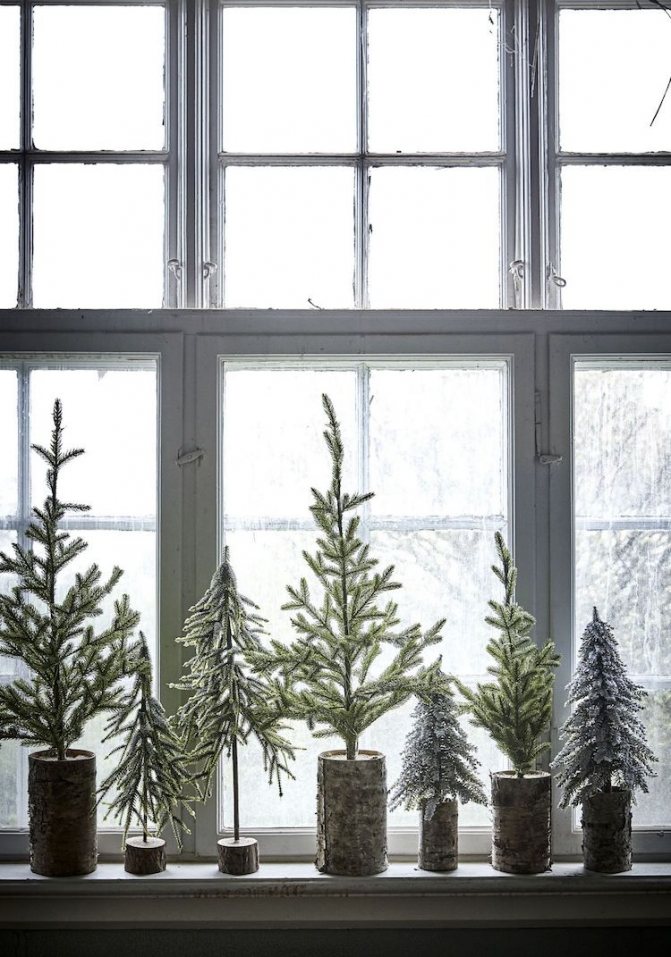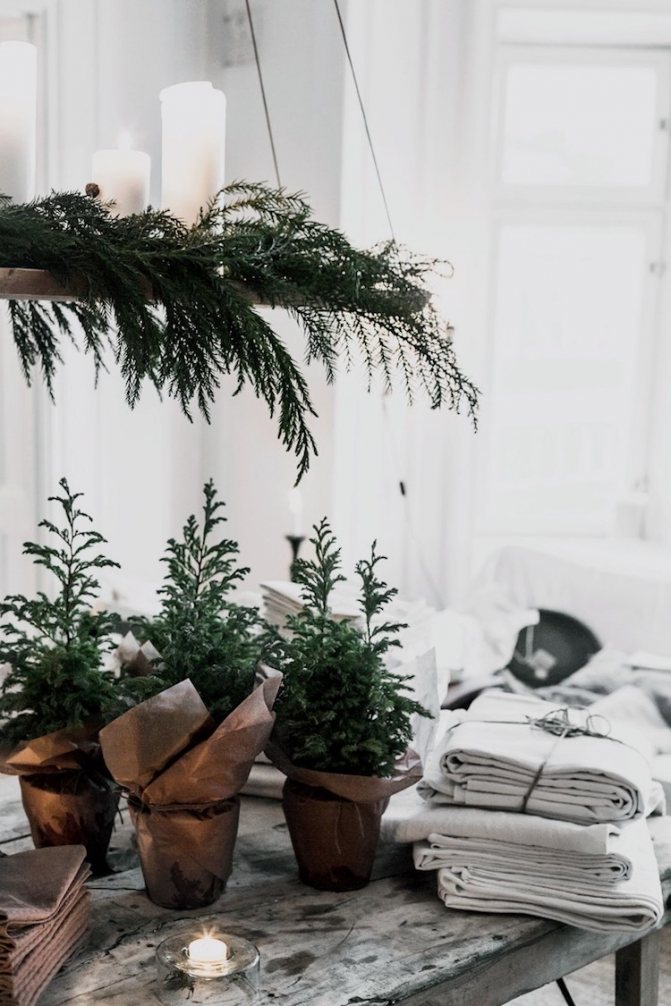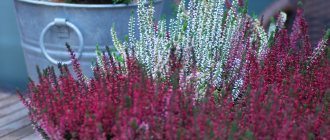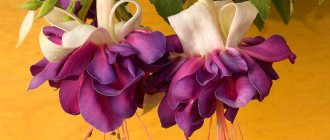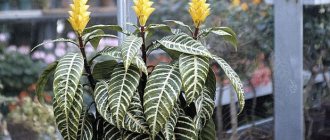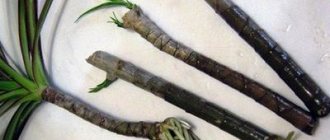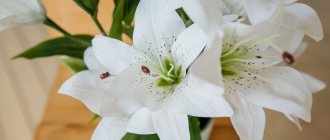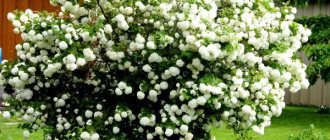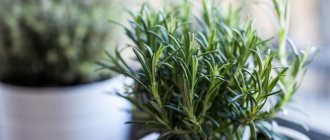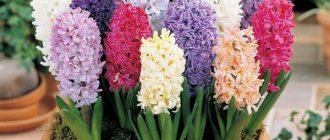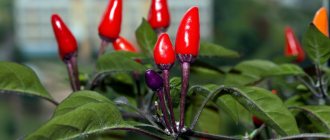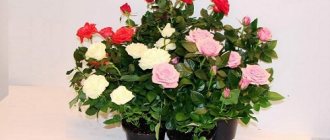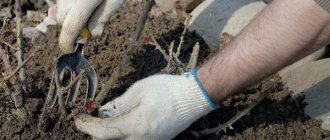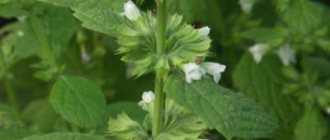It is generally accepted that the last weeks before the holiday is such a great time when everyone chooses gifts, decorates Christmas trees and bakes cinnamon rolls.
However, many different studies have debunked this myth: in fact, New Year's Eve weeks are some of the most difficult of the year in terms of stress and stress. Everyone is preparing for the holidays, projects are being completed, business is being closed, and children's parties, shopping and other pre-New Year fuss are superimposed on the increased volume of work.
It is not surprising that many of us dress up the Christmas tree for the New Year at the very last moment, or do not dress it up at all. What a New Year's mood here, if you just want to turn off the phone and go to the astral plane for two weeks!
Content rules
Lighting
In order to grow a Christmas tree at home in a pot, you need to properly care for it. The tree loves bright lighting. It is necessary to grow young specimens in a bright and warm place, while the pot of spruce should be protected from the rays of the sun. Otherwise, it may negatively affect the further growing of the tree.
Temperature
In the cold season, ate needs coolness. In this season, the temperature regime should range from +6 to +10 ° С. The forest beauty can quite easily tolerate freezing temperatures, only it is required to monitor the soil lump so that it does not freeze.
Watering mode
To grow a Christmas tree in a pot, you need to provide it with proper care. Watering is the main component in growing a forest beauty. The tree should be watered abundantly from March to September.
The soil is not allowed to be excessively wet or too dry. In winter, the frequency of watering is reduced to 1 time in 20 days if the temperature in the room is +6 - + 10 ° С. At a temperature of 0 degrees, the tree is moistened once a month. Professionals advise to spray the tree from time to time, especially during cold weather.
Top dressing
Spruce does not need regular feeding. In the summer, spruce is fertilized only about three times with universal dressings.
Earth substrate
If you want to grow spruce from seeds, then an acidic soil is needed for this. You can purchase an earthen mixture for conifers or prepare it yourself at home. It is required to take universal soil and soil from a coniferous forest in the same proportions, and mix all this.
Transfer
The spruce tolerates the transplant rather painfully. It is recommended not to disturb the earthen ball and to prevent the roots from exposing. You need to replant the tree 2 times a year, around May.
The story of one New Year's Living Tree
But I found this story of a Christmas tree in a pot on the site
A professional florist's advice on how to care for a Christmas tree and other conifers bought in a store in pots.
Spruce belongs to the pine family. Her homeland is the north of America, Europe and Asia. It is very difficult to grow spruce at home, but many, wanting to protect nature from the ruthless custom of destroying young trees, go for it.
For growing at home, inexpensive and unpretentious species are most suitable - common spruce, as well as Serbian, the needles of which are illuminated from below with silver. You can also grow indoor spruce - araucaria, it comes from the subtropics, and if the necessary conditions are met, it can be grown at home all year round.
The most common problems
In order to grow a Christmas tree at home in a pot, you should adhere to competent care, otherwise there may be problems with growing.
- The needles turn yellow and crumble. This usually occurs with improper care (sunburn, low or high temperatures, improper watering regime.) Affected branches cannot be restored. You can only make changes to the conditions of detention and use drugs that increase the immunity of plants. Funds are purchased in special stores.
- The needles wrinkled. This indicates that the earth is not completely oxidized. Add soil from under conifers to the top layer of soil. The roots of the tree should not be exposed, and the ground level should not be changed.
If you adhere to all the listed tips on how to properly grow a Christmas tree at home in a pot, then you can get a beautiful and lush spruce without much difficulty.
How to grow a juniper bonsai tree in a pot at home How to plant and grow a money tree at home? How to properly care for decorative indoor roses in a pot?
Canadian spruce at home is not easy, but still possible. But do not forget that in natural conditions, a spruce is a large tree, so it cannot be planted in a pot forever. And no matter how much you want to part with your darling, it is recommended to plant the tree in natural conditions until the age of 3.
Our Christmas tree was planted like this:
They dug a hole for the green guest much larger than the actual earthen lump of a potted tree, expanded clay and broken brick were poured at the bottom of the hole (do not forget that the spruce grows on rocky soil), then they mixed fertilizer for conifers (bought in the garden center) with the ground and poured broken bricks on top. Then they carefully took the tree out of the pot and placed it in the hole.
And when burying, they took the trouble not to cover it with earth above its root collar. In other words, they buried it exactly the same depth along the trunk as how deep it was buried in the pot.
The only mistake the new owner of the green treasure made was the orientation of the tree in space. He said that he "changed the orientation of the tree" :). It turns out Christmas trees have fluffier needles on the south side
, and this fact must also be taken into account when landing. But our Christmas tree was not offended and began to grow with its fluffy side to the east. Such a clever girl.
Storing the green guest on the balcony until spring will incredibly decorate the balcony, you can continue to decorate the Christmas tree outside.
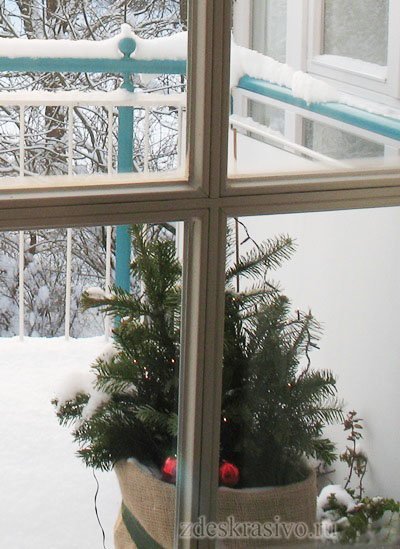
Canadian spruce in a pot: reproduction
You can buy a ready-made seedling in the store, or you can try to grow a Christmas tree from seeds. The seeds are collected from the open cones of a vending Christmas tree.
The best time for this is November-February. To ensure high germination of seed, it is recommended to carry out stratification. For this, the seeds are soaked in ice water for 3 days. Some gardeners even add ice to their water.
After the seeds are swollen, they are kept in wet sand at 0 ° C. With this method, the highest possible seed germination is ensured. Sow them to a depth of 0.5 cm. Until shoots appear, the pot should be in a well-ventilated cool place.
Remember that under natural conditions, spruce grows in early spring under snow. Further care - watering, feeding. Depending on the growing conditions and variety, seedlings by the age of one year can reach 10-25 cm, and dwarf species - even less.
Cones and seeds
First you need to find cones of a Christmas tree in the forest. They should not be revealed yet. You can collect cones from December to spring, but the best time is when the snow begins to melt. Found cones need to be dried - on a radiator, stove or in another warm place; they should be allowed to dry until they open.The tree seeds are laid out in some container and covered with snow. The vessel must be placed in the freezer and kept there for a long time - from a week to a month; it is advisable, of course, not to rush and let the seeds freeze thoroughly. Then the container is transferred from the freezer to the refrigerator for several hours, and then the seeds of the Christmas tree must be soaked in a solution of potassium permanganate. Now they can be planted in the ground.
The process of freezing the seeds of a Christmas tree is necessary to simulate as much as possible the conditions in which a spruce grows in nature.
Canadian spruce: placement
Having bought Canadian spruce in pots, it is best to place them on a cool but bright window. Conifers prefer diffused light. Fir-trees need frequent ventilation of the room. Watering should be optimal. Overdrying the soil is not allowed.
At home, there is a phenomenon when one side of a tree standing on a window facing the room begins to turn yellow and fall off. And the opposite side, being closer to the light, remains green. That is why the pot on the window must be turned periodically, otherwise one side may even crumble. And, as you know, spruce branches are not restored, since they grow only from above.
A Canadian spruce at home will grow better if you take it out on a glassed-in balcony or loggia in winter. It is important to ensure that the soil in the pot does not freeze. To prevent this from happening, the pot can be wrapped with something warm. At a temperature of about 0 ° C, the spruce will not freeze, but due to the humid air, it will feel very good. However, with the appearance of a bright burning sun, the Christmas tree needs to be shaded a little. This will prevent the young shoots from turning yellow.
Temperature
In winter, the forest beauty needs coolness, she can easily withstand a drop in temperature to a negative mark, but it is advisable not to do this. The optimum temperature in winter is about +6 - +10 degrees. At low temperatures, care must be taken that the earth clod does not freeze. In summer, the spruce must be ventilated and, in general, the tree will grow better if it is taken out onto a glazed balcony. From the scorching sun, the Christmas tree needs to be shaded so that young sprouts do not turn yellow.
Transplanting Canadian spruce into a pot
What you don't need to do after buying a Christmas tree in a pot is transplanting. Conifers can be transplanted only in late spring, but they do not tolerate even such a transplant.
If you have your own land plot, then you can try to transplant the Christmas tree directly into the ground. In this case, in no case should the earthen lump be damaged. You also need to make sure that the root collar is not buried. The landing site is chosen sunny, but shaded from ultraviolet radiation. The Christmas tree takes root for a long time - up to 3 years.
Step-by-step instructions for "moving"
So, how do you transplant a green beauty yourself? For this, it is worth considering the step-by-step process of all the work:
- preparatory work. Calculation of the radius of the root system. Pruning branches and tops of the tree;
- soil preparation;
- preparation of materials and tools necessary for work;
- the process of digging out a Christmas tree and freeing the root system;
- the tree and roots are carefully wrapped in a cloth bag;
- carefully fasten the bag on the trunk so that it does not sleep;
- prepare a planting hole. If the disembarkation is carried out in a garden area, the depth of the pit should be at least half a meter;
- we set the location of the south side. Our tree should be planted on the south side;
- gently lower the spruce into the hole. In this case, you do not need to remove the fabric bag, just slightly loosen the tied ends. Thus, small roots will not be damaged;
- put the fluffy beauty upright and sprinkle gently with prepared soil;
- gradually fill the hole with earth, gently tamping and watering it.
The move of our tree is completed. Now it remains to wait until it finally takes root in a new place and begins to delight you with its appearance.
Canadian spruce in a pot: care
Spruce needs a moderate temperature regime. Coolness is required during the winter months. The optimum temperature at this time is 0 + 10 ° С. The herringbone can withstand a short-term drop in temperature below 0 ° C.
Watering should be regular. It is necessary to ensure that the earthen lump is always evenly moistened. Excessive waterlogging and drying out is not allowed. During the rest period, watering can be reduced to 1 time in 2-3 weeks. This is at a room temperature of + 5 + 10 ° C. When the temperature drops to 0 ° C, water it no more than 1 time per month.
Top dressing is carried out with universal fertilizers. To grow conifers from seeds, you need acidic soil. To do this, you can buy a ready-made soil mixture for conifers, or prepare it yourself: in equal proportions, a universal soil mixture and soil from a coniferous forest.
Choosing the time of year for transplanting correctly
When can you “move” the Christmas tree? It is not recommended to postpone this grandiose event for the tree until the New Year. In this case, there is a great risk that our beauty will simply freeze and will not be able to adapt to new conditions.
What time of year is the most suitable for changing the “place of residence” of ate? An important factor influencing the success of transplanting is the condition of the soil. The soil should be sufficiently warm and moist. Therefore, the best options are autumn and spring. It is best if the work will be carried out during the rainy season.
Is it possible to arrange a "move" of the tree in the summer heat? Experts do not prohibit work at this time of the year. But it is worth observing the following nuances:
- it is not recommended to dig up a spruce during a period of extreme heat;
- the optimal period of time is in the afternoon, in the late afternoon;
- when digging up a forest beauty, you should also dig up a significant clod of earth. This is done in order not to violate the integrity of the root system of our tree;
- To make rooting in a new place easier, you can purchase a special solution of Kornevin liquid. With him, the process of adaptation to a new "home" will be painless.
Problems with growing Canadian spruce in a pot
The needles turn yellow and fall off. This happens as a result of mistakes when leaving: violations of the temperature regime, watering, sunburn. Branches that have already been damaged will not recover. If the needles began to turn yellow, it is necessary to urgently change the conditions of detention. The first aid may be spraying with bio-regulators, which can be purchased at specialized stores.
The needles have lost their shine and wrinkled. This is possible due to insufficiently oxidized soil. To change this, it is recommended to add coniferous soil to the top layer of the soil mixture. This must be done with extreme caution, without changing the level of the ground and not exposing the roots.
Agree that the New Year's mood will not be complete without a Christmas tree, along with which forest magic comes into the house, the room is filled with a unique aroma and incomparable comfort. But what if you try to leave a part of this mood with you for a whole year? And for all subsequent years? A Christmas tree in a pot, presented for the New Year, is not doomed to end up in a dump in a month, it will develop and grow, delighting its owners and giving them a New Year's fairy tale all year round. And the Konik spruce can be planted in open ground in the country, near the house, in any place of family and individual rest.
Features of individual varieties
Serbian (Balkan) spruce is considered the most slender among lovers of conifers.
Her decorative varieties Gnome (adult height up to 1.5 meters) and Nana (up to 3 meters high) look great on the New Year's holiday.
Among the blue (prickly) spruce trees in a pot, decorative varieties are in great demand:
- semi-dwarf Edith with harmonious shapes and blue-gray needles;
- Fat Albert with a bright color and regular crown;
- green with blue Glauka Globoza with a spherical crown.
Many Russian florists know how to care for the popular Canadian potted Konik tree. It grows very slowly, with an annual growth rate of up to 5 centimeters. Even in adulthood, the height of the plant rarely reaches one meter. Earthen sod with an admixture of leaves, a small amount of peat and sand serves as a nutrient soil for the plant. Konica is less capricious than other coniferous plant varieties. It can grow in a tub (pot) for several years.
The analogue of the variety is the decorative Canadian cone-shaped Christmas tree in the Sanders Blue pot. The spruce has soft, bluish-blue needles, an annual growth of up to 7 centimeters. With proper care, it grows for 50 years, reaching a maximum height of 3 meters. Loves light, moist fertile soil. In open ground it can withstand frosts up to 40 degrees.
Miniature varieties of Korean fir fit well into the interior:
- A diamond with dense dark green needles. By the age of 10 it grows up to half a meter, winter-hardy, loves moisture, moderate exposure to sunlight.
- Cis in the form of a small soft dense ball. Has bright purple bumps. Loves moisture, acidified sandy loam soil.
- Frost-resistant fir of Fraser.
- Oberon with a cushion crown.
Caucasian and Danish fir varieties are distinguished by a strict conical shape, soft fluffy green needles. For the New Year, golden, erect, gray-gray varieties of fir are also installed.
Danish farmers have successfully mastered the cultivation of the beautiful Nordman fir in tubs, which is in great demand in the capital cities on New Year's Eve.
Fir is unpretentious and durable. Home care consists in regular watering (without waterlogging), sufficient drainage of the soil. When planted in open ground, they grow up to 30 centimeters annually and can live up to 100 years.
The mountain fir Compact with flat needles, glossy silver overflow of needles is in great demand. Along with its proportional tapered shape, the unusual color shades have made it the best selling live potted spruce in many regions.
The brightest of the blue thorny spruce trees, Hoopsie, the leader of New Year's celebrations in Europe. Its main advantages are a strict crown cone, silvery-blue needles. Loves light, frost-resistant, unpretentious in conditions of increased urban gas pollution and air pollution.
In a series of varieties of ordinary trees in a pot, the German spruce Kupressina stands out. She has an original tapered ovoid crown, emerald green color of needle-like needles. The variety has shown good resistance to snowstorms and snowfalls.
Canadian Spruce Conic: Description
Dwarf Conic Spruce is nothing more than a mutation of Canadian spruce, which was discovered by dendrologists not so long ago, in 1904. This is a smaller copy of her older sister, she does not grow above 4 meters in her homeland and above 2 meters in the gardens of the middle lane. As a houseplant, Konik spruce does not grow more than half a meter in height.
Due to the reduced distance of internodes and increased branching, the bonsai looks very decorative and enjoys a well-deserved love among landscape designers and gardeners. It grows slowly, no more than 6 cm per year, and when it reaches a size close to its maximum, growth slows down and then stops, so there is no need to be afraid that over time it will shade other trees, or cover the facade of the building. Under favorable conditions, the life expectancy of a Canadian guest can be up to 500 years.
What's next?
Do not think that after "moving" ate to a new place, the work is completed. Now comes the hard and just as very important part - addiction and adaptation. To make them easier, you need daily care for the forest beauty. What needs to be done for this?
- Use fertilizers.
- Provide abundant watering.
- Remove weeds from the site in a timely manner.
- Monitor the condition of the soil.
- To make the adaptation of the root system painless, water the soil with a special solution "Kornevin".
- After planting, use the Aquadon solution for additional watering.
- Monitor the condition of the tree. At the slightest signs of wilting, try to add nutrients to the soil and replace the soil with a more familiar one.
Spruce transplanting is a rather difficult task. However, if all the recommendations and rules are followed, it will pass completely painlessly.
A green beauty spruce is not only a decoration of a personal plot, it is also needles that release phytoncides - volatile substances that have a detrimental effect on many microbes. You can create a hedge from Christmas trees, decorate it for the new year right on the site, enjoy its appearance for many decades.
Konika spruce: Planting and care, Photo
Planting in a pot:
As a rule, a coniferous plant comes to us in a pot, that is, with a closed root system. Young Christmas trees are sold in small pots, from the drainage holes of which roots that do not fit inside are already sticking out. If you bought or received just such a copy as a gift, it is advisable not to put it off "on the back burner" and make the "transshipment" of the plant into a suitable pot, 2 - 3 centimeters wider than the previous one. Conifers love acidic sandy-clay soils, so it is advisable to prepare a loamy soil with the addition of humus. Lay about 2 cm of expanded clay at the bottom of the pot, which will provide drainage for excess moisture, pour 1 - 2 cm of prepared soil on top, then carefully remove the plant from the pot along with a lump of substrate (soil) and install it in a new pot, filling the empty space around the perimeter soil. The surface of the ground can be mulched with pieces of pine bark (sold in garden centers) or sawdust.
Landing in open ground:
With some care, a tree can grow in a pot for years, but nevertheless, it is advisable not to torment it in the spring (until May), or in the early autumn to plant a tree in a country house or a personal plot. Konica loves partial shade, in the open sun it can get sunburn, which will adversely affect the appearance and health of the plant - you need to take this into account when choosing a planting site. Also, the site should not be swampy, since stagnant water will lead to the death of the tree.
The main part of the roots of the Canadian dwarf spruce is located near the surface, therefore, fertilizer should also be introduced into the surface layers of the soil, near a bucket of humus per 1 m2, while carefully digging up the planting site. To slow down the evaporation of moisture from the surface of the earth, it is advisable to mulch it with bark or sawdust.
Dwarf tree in a pot, how to care
Caring for a tree grown as a houseplant consists in observing the temperature, light and watering regime.
In winter:
Since the birthplace of this Christmas tree is Canada, in winter the tree needs to be provided with rest by placing it in a well-lit room with an air temperature from 0 to 10˚s. If you leave Konika in a warm room, its twigs may turn yellow, and life cycles will be disrupted, so a cool loggia, balcony, veranda is the best wintering option. Watering in winter is enough 1 - 2 times a month, but do not overdry the soil too much.
In the spring:
After leaving the winter rest, it is advisable to feed the conic spruce with combined fertilizers, since it is at this time that it grows new bright green twigs.
In summer:
Spruce tolerates summer well, provided that it is not in direct sunlight, but in a sufficiently lit place. Watering in the summer is necessary at least once a week, making sure that the earthy clod does not dry out, but also that there is no excess moisture. It responds well to moistening needles from a spray bottle.
Canadian Spruce Conic in the garden, Care
If the planting conditions have been met, the coniferous beauty should not give you many problems. She only needs summer watering, about 2 times a week and spring feeding, for which she will thank him with good growth.
Due to its modest size, there is a place for an evergreen tree literally anywhere in the garden, and even in a relatively small flower bed. It does not need to be shaped, since by nature it has a beautiful lush conical crown.
Winter holidays are approaching.
And, of course, not a single New Year is complete without the forest beauty of the spruce, which brings all children into indescribable delight, and helps adults to return for a few days to the distant country of childhood, where a fairy tale lives and the most cherished desires come true.
Shortly before the New Year, felled trees appear on sale, but after installing a coniferous tree at home, after a week it begins to crumble, even if it is in a bucket of wet sand.
And the holidays last much longer and I want the Christmas tree to delight us all this time.
This is really possible if you get a live Christmas tree in a pot of soil. In Europe, such Christmas trees have long been popular, although they are more expensive than felled ones. Here are some tips on how to maintain a potted Christmas tree to make it feel comfortable in your home.
Before you finally install the spruce in the room, you need to gradually accustom it to home warmth. To do this, keep it in a cold garage or on a glassed-in balcony for several days. But just put the pot on a piece of wood, not cement. And in case of frost, it is advisable to wrap the pot with something warm, because the ground can freeze along with the roots. It is warm in the ground in winter, and in a small pot it can freeze.
When you bring the tree into the room, place it away from the heaters. It is advisable to put an electric humidifier in the room or, at least, a vessel with water, because coniferous beauty needs humid air.
You can decorate the Christmas tree only with the lightest New Year's toys.
Water the tree in a pot sparingly, as the soil dries out (about 2 times a week), avoiding either drying out or waterlogging of the substrate. It is also necessary to regularly spray the tree. It is better to use water for spraying and irrigation thawed or at least settled, at room temperature.
But even in such conditions, it is not advisable to keep the Christmas tree in the room for more than 3 weeks, because most of all, the coniferous beauty suffers from dry air. Unfortunately, as much as we want, the tree cannot become a houseplant. It requires cooler light conditions and moist fresh air to grow.
You can, of course, try to settle it on a glazed loggia, only if you do not have a sunny side. But still, there is no guarantee that it will take root there. It is better to plant the tree in the ground on a frost-free day, for example, in the country house or in the yard (if you have your own private house). When planting in the ground, do not deepen it much - you need to leave the root collar at the same level as in the pot. When planting, in any case, do not disturb the earthen lump, ate, and they do not tolerate transplanting so well.
But if you still want to decorate your own Christmas tree every New Year, you can purchase one of the conifers that are easiest to adapt at home. Such plants are: cypress, thuja, cryptomeria, araucaria and some others. As a Christmas tree, give preference to araucaria, because it comes from the subtropics and, moreover, looks more like a herringbone. In any case, you decide which tree will decorate your house on New Year's Eve.
Plant selection
When buying a variety of coniferous tree seedlings, you need to take into account its adaptability to life in the cold conditions of our climatic zone. Ideal for:
- ordinary spruce or pine;
- dwarf spruce conic in a pot;
- ate prickly, Serbian;
- decorative blue spruce of Dutch, Danish, North American or Russian varieties;
- fir growing in Siberia, Korea or the Caucasus mountains;
- columnar western thuja.
When choosing a seedling, you need to make sure that it was not transplanted into a pot or tub yesterday. To do this, it is enough to gently move the trunk, rake out the top layer of soil. If in doubt, ask the seller to carefully pull out the plant, inspect the root ball, the condition of the root system. It should be intact and densely branched.
Ate loves content in acidified peat-based soil mixtures. If the tree was grown from the very beginning in the same container, the roots of the plant will be evenly spaced throughout the pot. Its size should be proportional to the crown of a living tree in a pot. Miniature tubs, pots most often indicate the use of various growth stimulants and the low probability of successful further transplantation of such conifers in a summer cottage near the house.
Dense needles dyed in one color, a strengthened root system testifies to the health of the seedling, good prospects for its further growth.
Safe places to buy spruce are nurseries and specialist gardening shops. Now in big cities, the most humane way of using Christmas trees has begun to appear. After growing in special nurseries, buyers are offered to rent them for New Year's celebrations for a period of 17 days. After that, the tenant returns the plant to the nursery, where experienced specialists take care of it, and with the onset of warmth, spruce trees are planted in forest parks, on alleys, and other designated places.
In order not to damage the branches, the trunk of the tree, do not overload it with toys, decorations and garlands.
Evergreen beauty spruce in landscape design
The evergreen spruce is a spectacular plant that lends a unique charm to any planting. The prickly beauty often becomes the accent of a landscape composition, creating a unique artistic effect, filling it with depth of color, volume, and setting a cozy and somewhat mysterious mood.
There are more than 50 species of this plant, common in the Northern Hemisphere. In nature, conifers grow in mountain forests, rarely found in flat areas.
Coniferous plants take root well on river banks, where they receive sufficient flowing moisture, avoiding highly waterlogged soils.
Common spruce (European), which is the main species for logging, is widespread in Russia.
Spruce in landscape design for relatively small areas is mainly used of medium-sized (10-15m in height) or dwarf species (up to 2.5 m), since traditional beauties can reach heights of 40-50m and higher.
Planting a Christmas tree
The seeds of the Christmas tree are planted in the prepared soil shallowly - about a centimeter. From above, they are sprinkled with soil mixed with pine needles or sawdust. Now the soil must be constantly moistened and kept in a lighted place, but not in direct sunlight. It is important to remember that ate, unlike many flowering plants, needs coolness to germinate. To create the desired microclimate, you can make a small greenhouse. To do this, sticks are stuck into the ground (for example, matches or toothpicks), and a plastic wrap is placed on top of them.
I must say that the seeds of a Christmas tree sprout for a long time - over several months. For those who until now have dealt only with vegetables, fruits and garden flowers, such a period may seem unusual. You should not rush things, you need to wait patiently before the seedlings appear above the ground. By the way, ate sprouts also do not look like the usual tomatoes or cucumbers: instead of two cotyledons, they have several young needles.
Pots for fir trees are advised to be selected in such a way that they can grow in them for several years, since it is undesirable to transplant young Christmas trees. However, others say that the first transplant can be done when the plants have reached two centimeters in height.
Be that as it may, young Christmas trees are kept in the same conditions as seedlings: coolness, light and high humidity. You can keep trees on the balcony, and if they are grown in an apartment, then you do not need to place them near a radiator, stove or other heating system; there must be a container of water next to the pot.
The next tree transplant is done a year later, and then three years later. It is necessary to transplant in cold weather.
At the age of three or four, when the tree has already grown half a meter, it can be planted in open ground. Before this, for a long time, the plant must be accustomed to the outside air, periodically taking it out of the room during the day; and when it reaches the age of three months, you can take it out at night.
After planting in the open ground, the tree must adapt to the new place. To make it easier for her to get used to it, you need to pour a little earth from the forest into the hole, which is well known to our tree. Until it takes root, it needs to be watered from time to time.
Small Christmas trees are advised to keep in the house. They saturate the air with oxygen and phytoncides - odorous substances that are useful for the body, and also emit a pleasant pine aroma.
Representatives of decorative forms of spruce
Decorative forms of coniferous trees have consistently slow growth rates and small dimensions. Aesthetic appeal and practicality - these two principles, on which breeders were based, creating new subspecies of spruce, are fully embodied in representatives of popular breeds with a spherical, cushion or conical crown configuration.
Tufty, Cinderella, Petra, Hillside Upright, Emsland are the most attractive forms that delight the eye with golden-green and bluish shades of needles. Dwarf beauties have a dense compact crown, while the lower branches cover the near-trunk area of the earth.
Quite remarkable is Picea glauca with bluish needles and its varieties Conica, Cupido and Pixie, which gardeners consider to be the shortest forms.
How to prepare and select seeds for sowing?
Growing spruce from seed is the most reliable way. The seed should be of good selected quality, which can be purchased at the nursery, or you can get it yourself from the spruce fruit - cones. Cones are harvested in mid-February, since during this period the seeds are considered especially complete. The collected cones are placed in a cloth bag, which must be placed next to the battery. After a few weeks, the dried cones open up, creating free access to the spruce grains. Next, the seeds must be gently rubbed together to free them from the lionfish, rinsed under warm water, eliminating a possible oily film that can form due to the secreted essential oils. At the end of the preparation, the seeds are dried.
To provide the planting material with full protection from microbes, it is washed with weak potassium permanganate, wiped with a cloth, placed in a glass, tightly closed jar and sent to the refrigerator. The seed freezer creates conditions similar to their own. They are hardened here, undergoing stratification that improves germination.
Proper care of a Christmas tree in a pot
The original representative of the Rainbow's End conifer family is unusually beautiful and elegant in summer thanks to milky-white young shoots. The unusual shape of the crown and the juicy shades of the needles make her a desirable inhabitant of the garden.
Spruce blue or prickly - one of the most decorative and unpretentious breed in care.A distinctive feature of the Picea pungens breed is its tetrahedral and rather spiny needles, which change shades of color from green, gray-gray, bright blue to almost white. The depth of the shade depends on the wax coating that envelops the young needles. The light-loving beauty grows well on light fertile loams. Medium-sized varieties of the breed have a conical crown: Snowkist, Hunnewelliana.
How many years do Christmas trees live?
I must say that among conifers, Christmas trees cannot be called centenarians: they rarely live up to three hundred years of age. They usually live up to 150 years; age depends on the type of spruce and the place of growth. However, the roots remaining from the dead trunk can give rise to new clone shoots; if all clones from one root are considered one plant, then the spruce's lifespan increases significantly: the oldest such tree - Old Tikko - lives for almost 10 thousand years. It is located in Sweden, on Mount Fulufjellet. It is the oldest woody organism on Earth.
Since the branches of the Christmas tree, like the araucaria, are located in "floors", you can determine the age of the tree by counting the "floors", each of which corresponds to one year, and adding 3 - 4 years required for the formation of the first "floor".
Fir trees grow in the forest quite close to each other, which makes the fir forest the darkest among all other types of forests. In summer, it is never hot in it, since most of the sun's rays do not penetrate into it. This feature of the spruce trees was one of the reasons for the cold resistance of the plant - a cool temperature is needed for the spruce seed to germinate.
The Christmas tree is an evergreen tree, but in the fall it sheds one seventh of its needles. Of course, in this sense, larch is more effective, which sheds all the needles for the winter, which is why it got this name. Spruce needles are used to prepare fortified feed for livestock, however, an infusion of needles will also be useful for humans.
Grow a tree from seeds and let it never cease to delight you!
How to care for a live Christmas tree in a pot, where to store, how to transplant, where to transplant and whether it is worth doing.
Last year we were presented with a live New Year tree in a pot. The tree was about 40 cm. The pot was small, but the roots were not visible, and the tree was entwined with a New Year's garland on batteries. She was carried, and she was all overflowing.
I did not think about replanting her, as there is a lot of warning negative information on the Internet. And I didn't have time to look after her. But, having stood on my windowsill in the kitchen for 10 days, she released young light green shoots. To be honest, I didn't know what to do with it, I watered it a little, but the pot was so small that the water immediately flowed out and maybe that's why it began to turn yellow at the ends of the shoots, however, the sun was shining directly on it through the window. Having decided that this is still not a houseplant, but an outdoor plant, I took it out onto the balcony and sprinkled the pot with snow.
Our winter was warm, when the snow fell, I sprinkled the Christmas tree with new snow, then the snow melted and by itself slightly moistened the ground under the Christmas tree. Spring has come. As it turned out, the balcony is not a place where trees can grow. My balcony faces east and after lunch the spring sun scorches young needles, watering is also a problem, well, I don't want to go out onto the balcony in early spring and garden, besides, the pot is just a kid's for such a Christmas tree. And in the spring, at the end of March, I gave the tree to a private house. She was taken out of the pot and dropped off next to the house. And, lo and behold! The Christmas tree began, and now it has been standing in this place for almost a year. That is, it was planted last spring in March 2019, and now it is January 2019. She grew 7 cm. Here is our Christmas tree.
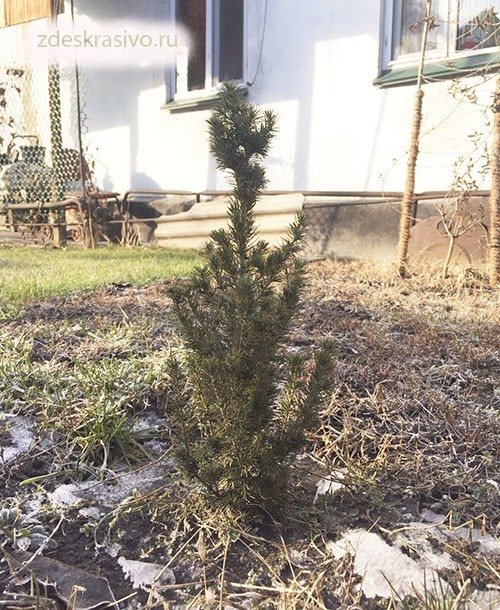

Fortunately, unexpectedly for myself, I managed to fulfill all the conditions for caring for a Christmas tree in a pot.
Landscaping and conifers
Dwarf tree forms with different shades of conifers look interesting on rocky slopes near a stream, on alpine hills. Successful neighborhood of babies with ornamental shrubs, perennial flowers and ground cover plants. Spruce goes well in composition with heathers, erik.
The variety of shapes and shades of conifers allows you to create a rocky landscape corner that will delight the eye all year round.
The prickly beauty is easy to cut, which allows you to create original forms by growing decorative hedges with a height of 1.5-3 meters.
Spruce in landscape design is good in any form: whether it is a separately growing dominant, a group planting of conifers along an alley or a composition with flowering shrubs and flowers.
A tree planted with solitaire looks most advantageous against the background of an emerald velvet lawn.
A medium-sized spruce, planted near the house as a dominant plant, can act as a visual counterbalance to the volumetric structure of a building. The freestanding coniferous beauty is spectacular in winter as the main element of the New Year's holidays.
However, it should be borne in mind that superficially located plant roots do not tolerate tamping and damage. For round dances around the dressed-up beauty, you should cover the near-trunk area with a protective tiled path.
How to keep the New Year's beauty longer so that she pleases with her live green needles? You can use some tricks to keep the felled tree from withering for a long time. Young cuttings or dwarf spruces in containers are gaining great popularity - they will decorate more than one holiday. At home, they need special care. Remember to water properly tree
.
You will need
- Spruce, felled or in container
- Water and salt
- Glycerol
- Aspirin
- Gelatin
- Sand
- Pallet and pot with holes in the bottom
- Spray
Classic
White color certainly evokes associations with snow and winter forest. Designers advise choosing a Christmas tree decor in white and silver colors. Solemnity and magic will help to create white balls, tinsel, rain, silver stars and matte white garlands.
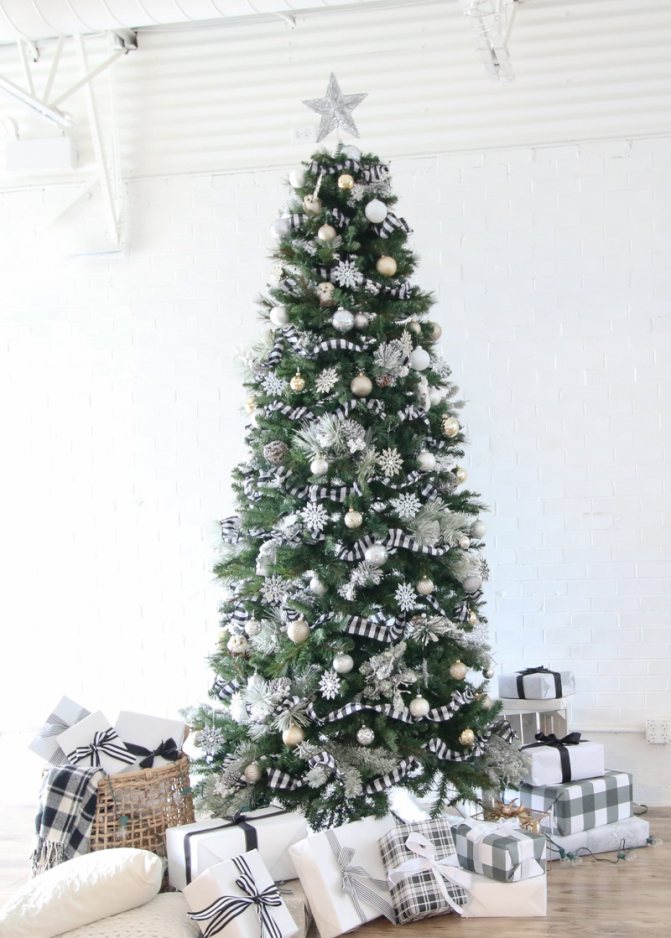

If you are a fan of tradition, use white decor
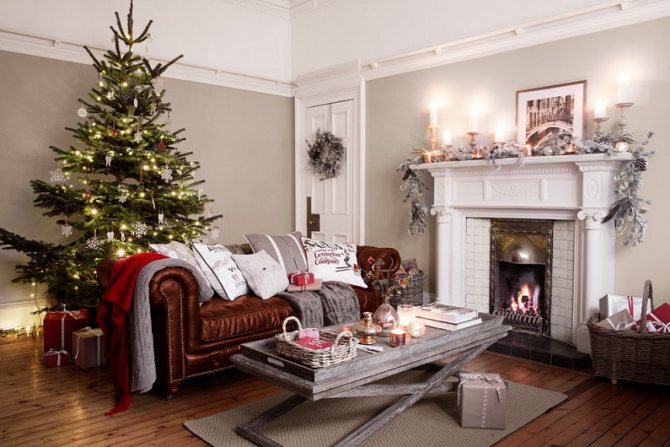

If the tree is fluffy enough, there should not be a lot of decorations on it.
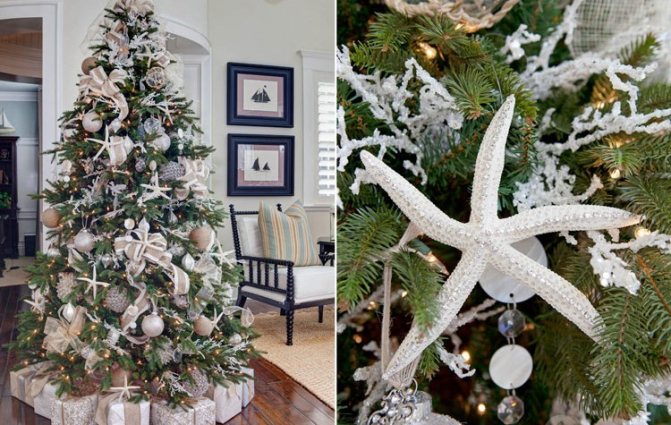

Decorate the tree with white twigs, this will create the illusion of frosty frost.
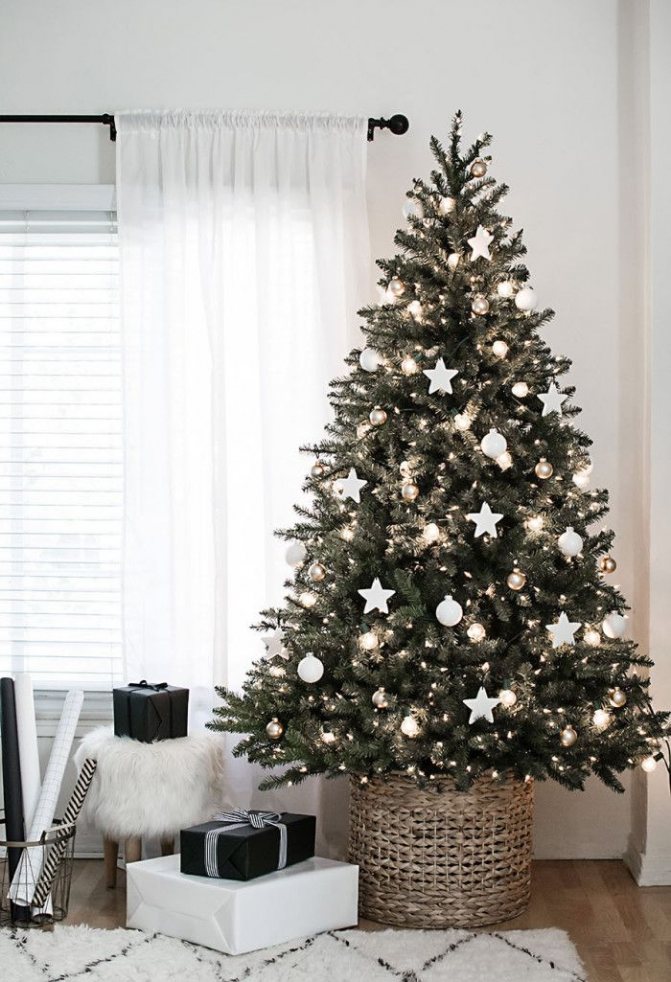

Place the garlands deeper in the branches - it looks fabulous
Alternatively, you can dilute the white with red and gold - this is a traditional Christmas color scheme.
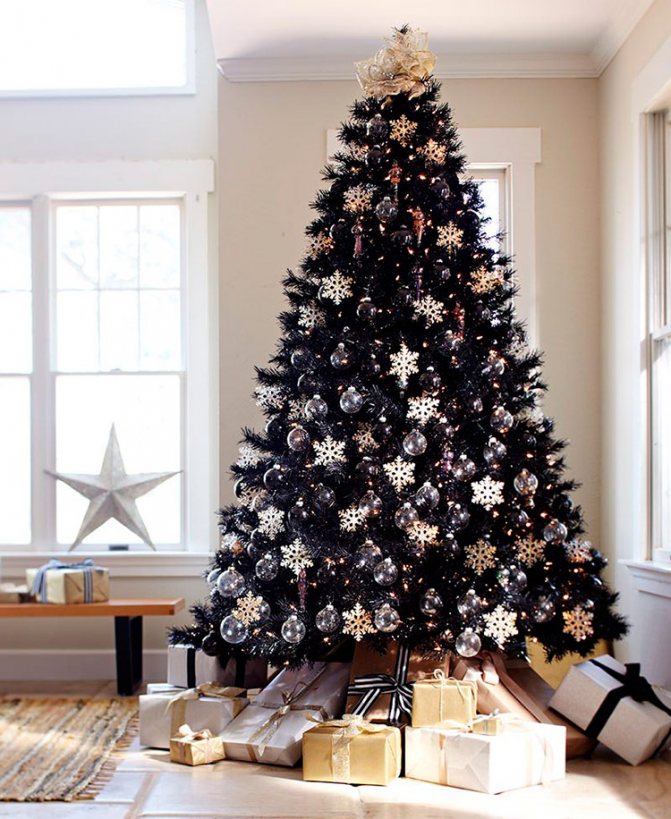

The warm shade of golden decor lends the wood a luxury
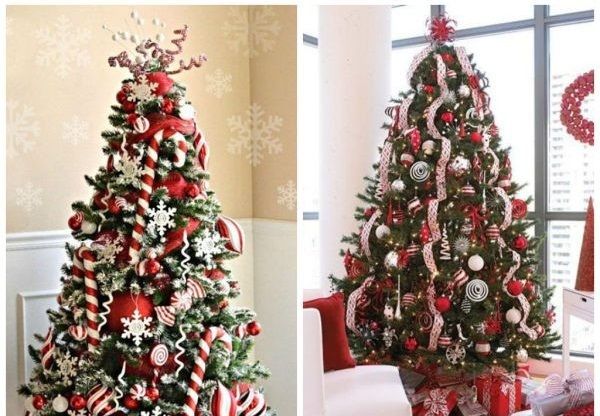

Red and Gold Decorations - New Year's Classics
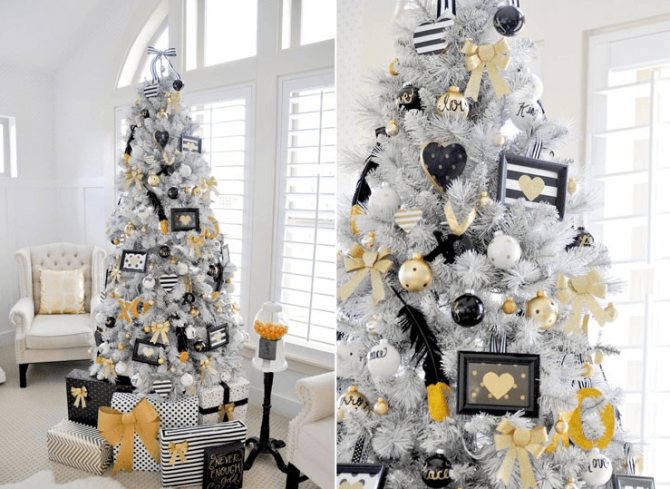

Gold and black decorations look stylish on a white Christmas tree
Garlands located in the middle of the tree between the branches look good. Their dull light shining through the paws of the tree is mysterious and unusual.
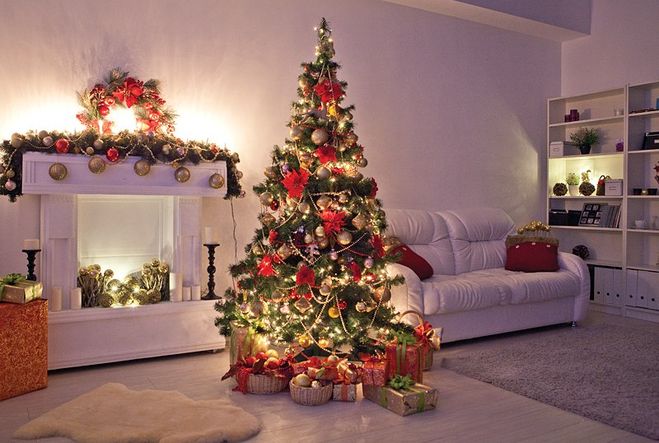

Small garlands hidden in needles look good
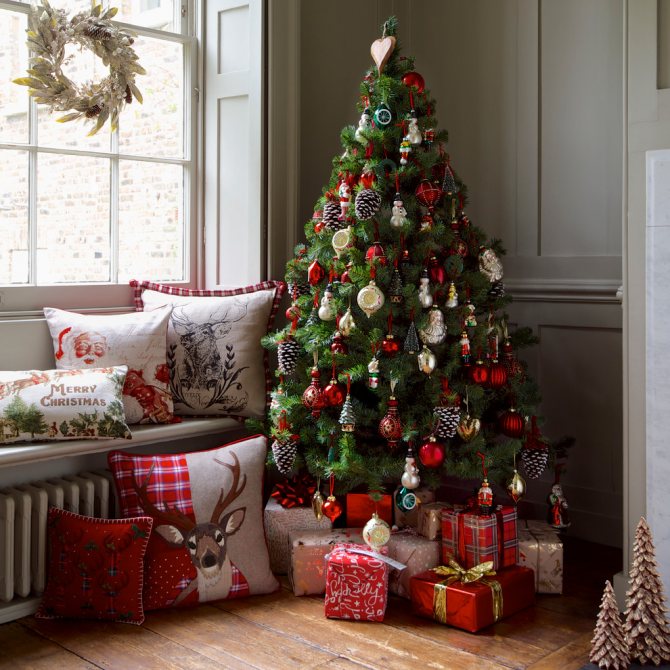

Pine cones on a tree can also be an excellent decor.
Instructions
Cut the stem of the felled tree at a 45-degree angle and place it in the bucket with sand.
Pour in a liter of water. The sand should never dry out! Some craftsmen water the New Year's plant with salted water, which allows it to stand in the house until March and not dry out.
Dissolve a tablespoon of sugar in three liters of water, add an aspirin tablet and a little gelatin and pour the chopped down tree
every 2 days. In addition, you can use a solution of glycerin (50%) to water the tree once a week so that the needles do not crumble for as long as possible.
Buy tree
in a container - it will stay with you for at least 2 years, after which it can be planted in open ground. Take a plant with elastic branches and a fresh root system that is in moist soil. Try to break the twig.
Spring transplant
With the onset of warmth and sufficient thawing of the soil, you can transplant your winter beauty from a pot into open ground.It is advisable to do this before the plant begins to flow. A free, well-lit place is best suited for planting. We carry out the transplant sequentially:
- We are preparing a spacious pit so that the roots of a coniferous plant are spread freely, evenly in the prepared space.
- We lay a sand drainage with a depth of 20 centimeters at the bottom.
- We prepare an earthen mixture for backfill, consisting of two parts of turf, one part of peat and one sand.
- When installed in a hole, the root collar of the plant should be level with the ground.
- We fill up the hole, compacting the soil layer by layer.
Fertilizer when planting is used individually, taking into account the characteristics of the variety and the state of health of your tree.
Gradually, after each New Year, a new coniferous seedling will appear on the garden plot. The Christmas tree alley will delight your eyes and warm your soul for a long time.
Spruce Konica: Home Care
If it is flexible, does not break immediately with a bang, then the Christmas tree is alive, recently dug out of the ground.
Place the tree in a dry and warm room and supply it with water in a sump - it will take in as much moisture as it needs. Do not allow the soil to dry out, or the stagnation of water in the pot. Plant breeders advise against watering the spruce with fertilizers while it is in a warm room. Spray the needles regularly with clean water from a spray bottle. At the end of the New Year's holidays, place the plant on a glazed loggia or in the canopy of a private house.
If you opted for a felled tree, first allow it to acclimatize in a cool place (for example, in the hallway by the front door). Before placing the spruce in a bucket of sand, the trunk cut must be updated.
Attention, only TODAY!
Kozelsk, Optina Pustyn, Shamordino, hotels, bus schedule, news, excursions, Pryski, Berezichi, Deshovki, travel, pilgrimage, Kozelsk travel and excursion bureau, rest, Ugra, Zhizdra Kozelsk, Optina Pustyn, Shamordino, hotels, bus schedule, news , excursions, Pryski, Berezichi, Deshovki, travel, pilgrimage, Kozelsk travel and excursion agency, rest, Ugra, Zhizdra Kozelsk, Optina Pustyn, Shamordino, hotels, bus schedule, news, excursions, Pryski, Berezichi, Deshovki, travel, pilgrimage, Kozelsk travel and excursion bureau, rest, Ugra, Zhizdra Kozelsk, Optina Pustyn, Shamordino, hotels, bus schedule, news, excursions, Pryski, Berezichi, Deshovki, travel, pilgrimage, Kozelsk travel and excursion bureau, rest, Ugra, Zhizdra Kozelsk, Optina Pustyn, Shamordino, hotels, bus schedule, news, excursions, Pry ski, Berezichi, Deshovki, travel, pilgrimage, Kozelsk travel agency and excursion oi, rest, Ugra, Zhizdra Kozelsk, Optina Pustyn, Shamordino, hotels, bus schedule, news, excursions, Pryski, Berezichi, Deshovki, travel, pilgrimage, Kozelsk travel and excursion bureau, rest, Ugra, Zhizdra Kozelsk, Optina Pustyn,
A live spruce in a pot is the best option for celebrating the New Year. Unfortunately, this pleasure is not available to everyone. And all because spruce trees are grown for a very long time and the most beautiful trees cost a little more than felled and artificial ones. However, you should still buy a live Christmas tree in a pot. After all, such a tree has a lot of advantages.
Why is a spruce in a pot so good?
A tree in a pot is the embodiment of all the virtues, both felled trees and artificial ones. And all because the needles do not crumble and the smell of the needles is fragrant and rich. It is suitable for people who care about the environment and against the deforestation of coniferous forests. After the holidays, live spruce trees are easily transplanted to the site and you can continue to enjoy the beauty of the plant all year round. The plant in the container grows as a solid lump of earth. A tree that has not been felled and has no damage to its root system.New Year's trees in pots fill the room with a coniferous aroma. It is persistent and much richer than cut trees. Spruce in a tub will become an unpredictable gift for your loved ones!
And, as you know, such a scent is healing and can kill most bacteria. The scent of pine needles freshens the air and stays indoors throughout the entire period. Also, the spruce needles in the pot will not dry out and crumble. If you water the plant correctly, then there will be no problems. This means that after the holidays you will not have to remove many fallen needles. Another advantage of eating in a pot is the ability to rent a plant for several days. This is very convenient for those who love nature, but do not have the opportunity to grow spruce in the open field in the future. Short-term use of the New Year tree will be economical. After all, renting a spruce in a pot is cheaper than buying.
Decorating a Christmas tree in a pot with the whole family
The Christmas tree is a symbol of winter holidays, you simply cannot do without it! A live spruce in a pot can be an excellent addition to the New Year's interior of any room. Such New Year's trees perfectly decorate both residential buildings and office premises. Every year, everyone celebrates New Year's lights. And the main characters are always gorgeous Christmas trees. Therefore, a live spruce in a pot will be the best option for New Year's decoration. You can decorate such plants with various New Year's toys and garlands. They look very harmonious.
Also, a tree in a pot is easy to transport. After all, the plant is planted in an earthen coma and holds on tightly there. And you can put the tree in any free corner, the main thing is that there are no heating appliances nearby. Live spruce trees can be purchased in different sizes and create magnificent New Year's compositions from them. The dwarf spruce in the Temariks tub looks great. The pot can also be beautifully decorated. They put him in beautiful baskets made of vines. You can also decorate the pot with New Year's paper, appliques, and other festive decorations.
table decor and gifts
A little decorating trick: a small Christmas tree or a composition of spruce branches is best placed at eye level, then they will set the mood as effectively as a full-fledged Christmas tree.
And one more important point: branches and mini-trees should not be overloaded with decor, the number of toys (and their size) should correspond to the size of the entire composition, and the color scheme should not be too variegated.
Well, the main trend of recent years is a mini-tree made of twigs in gift wrapping. The branches are attached to craft paper with double-sided tape (the glue will not cope, as the branch continues to release moisture).
Holiday greetings!
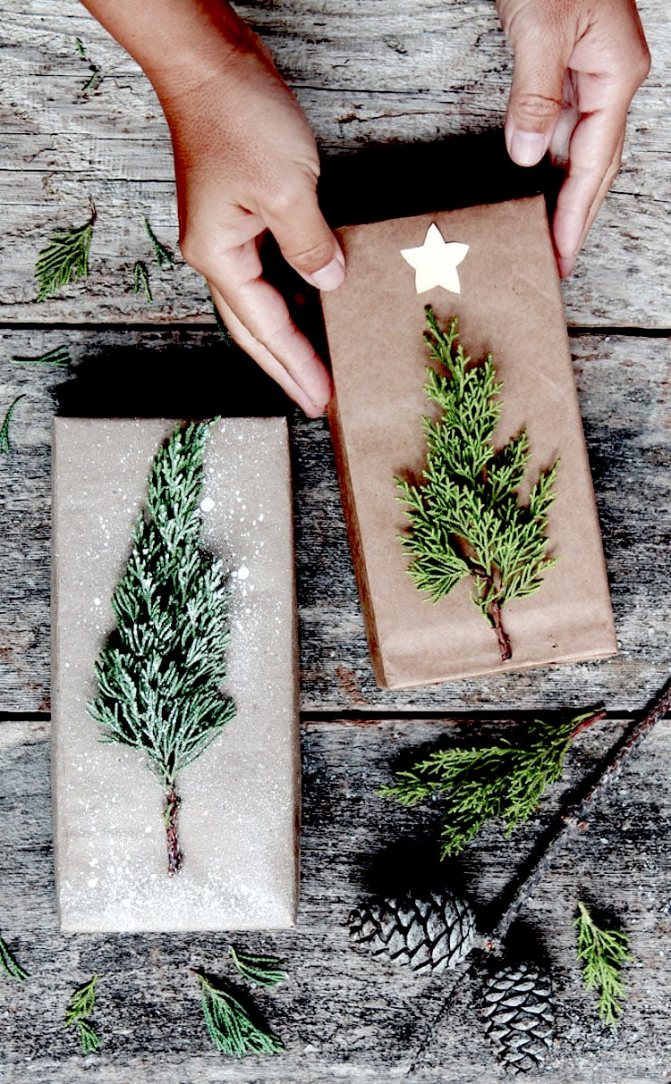

Canadian spruce. Caring for a Christmas tree in a pot.
Such ideas will be a great occasion to get the whole family together and decorate the Christmas tree together. I was interested in the Christmas tree - you can buy it in the garden
A live Christmas tree in a pot is a very beautiful evergreen plant. Buying it will bring the whole family a lot of positive emotions. But it is worth remembering that such a plant requires regular maintenance. Namely, the correct temperature and watering. But there is no doubt that the benefits of a spruce in a pot are much greater than that of a felled or artificial New Year's tree. Live New Year's spruce will decorate your home, and later will become a decoration of your garden or cottage!
Indoor conifers look very beautiful.
Everyone knows that a walk in a pine forest gives vitality and energy, but few people think about creating such an attractive and useful forest at home. Evergreens will delight you with their attractive appearance both in winter and in summer. If you are not afraid of trouble and develop at least a little in the flower business, then it will be quite real for you to grow indoor conifers.
It should be noted that the main plants that are grown at home include: araucaria - a small indoor Christmas tree, which is very similar to the real one, only much smaller in size.
Yew plants, which have a number of species designed specifically for indoor cultivation. With different color, shape and crown size; western and eastern thuja with a decorative gray-green color of the crown; cypresses, among which for lovers of indoor coniferous species, sad, pyramidal and Mexican cypress is suitable; there are also small ornamental plants of the pine family, which include cedar, Italian pine and legcarpe.
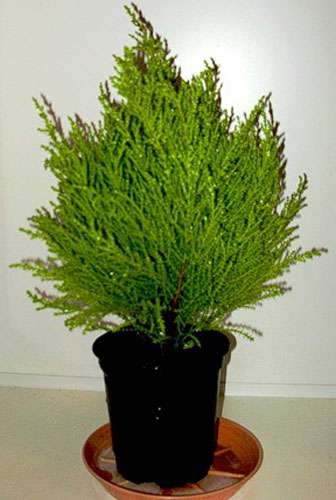

It should be noted that when growing conifers, the conditions are almost the same as when breeding any other flowers. It is recommended to place pots with such plants on windows or opposite transparent doors that face the north or northeast side.
In order for the crown of your conifers to not turn yellow or dry out, it requires a large amount of external moisture, which you can provide with two daily spraying.
Mandatory moistening of the earth in a pot should not turn into waterlogging of the soil. Watch carefully how indoor conifers behave from the slightest lack or excess of moisture. Both watering and spraying of conifers should be done with water at room temperature, preferably clean and without any impurities.
Room
conifersplants
do not like to be disturbed. Therefore, if you do not have such a need, it is better not to touch them or move them from one place to another, but do not forget that in the warm season they will be grateful to you if you take them out into the fresh summer air.
It is best to replant plants in April or May, but this should be done no more than once every 3 years. When replanting plants, take into account its possible growth, and select a pot according to the possible size of your plant in 1-2 years. When transplanting, you need to be careful not to damage the root system, which is very poorly restored.
The fact is that on the roots of all coniferous plants there is a special fungus - mycorrhiza, which is necessary for the life and development of conifers.
Silvery haze
Add cotton wool between the paws of the needles or artificial snow. The silvery rain in the depths of the branches also looks good.
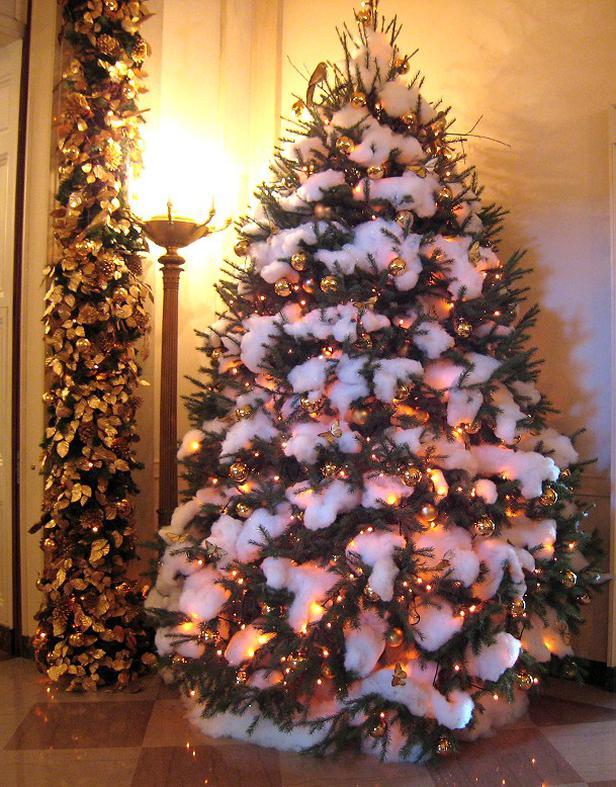

You can make artificial snow with cotton wool
You can also use aerosols or silvery fabric dyes. The Christmas tree will sparkle in a new way, creating the illusion of sparkling snow shining.
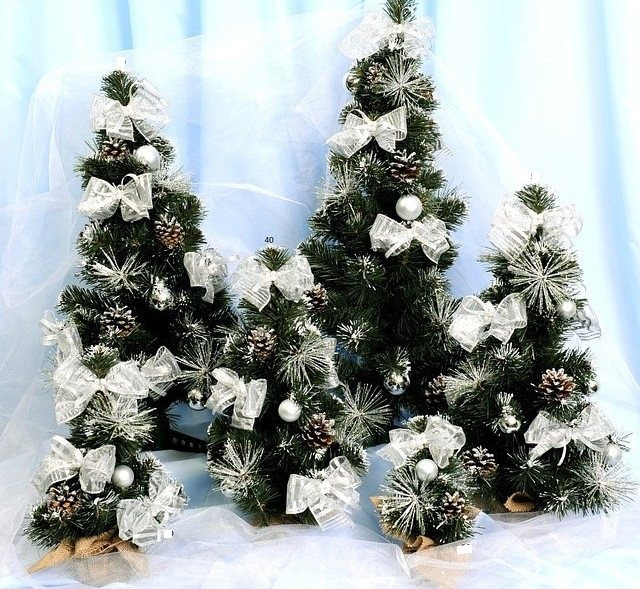

Individual needles can be dyed silver
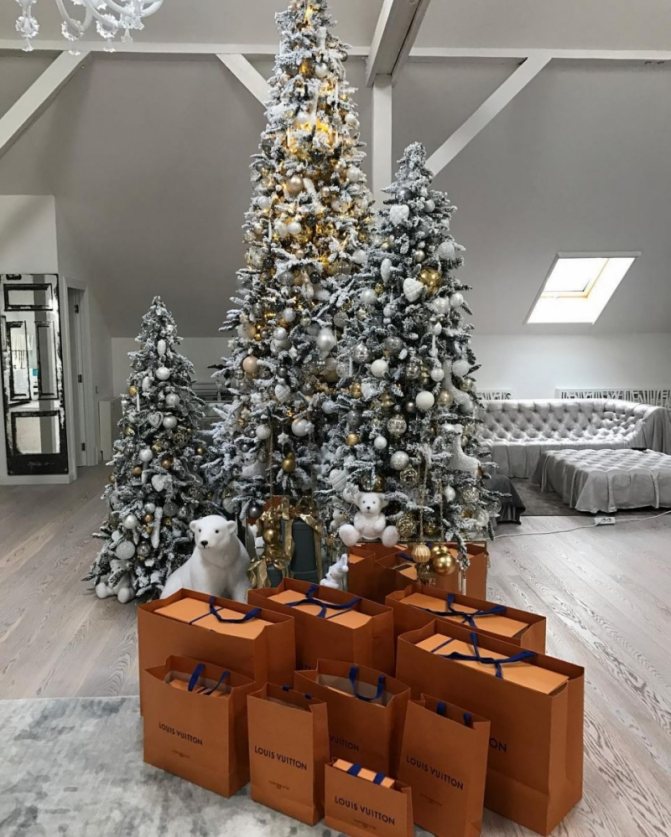

Herringbone covered with artificial frost is a stylish decision of the season
How to care for a live Christmas tree in a pot before and after the New Year?
Protect conifers from direct sunlight, especially if the plant has just been transplanted. In this case, it is best to remove it in the shade or under a canopy.
For the wintering of conifers, it is best to find a cool place. The optimum temperature is 6-12 degrees. In order for indoor conifers to overwinter without problems, you need to prepare for this process from the end of summer. To begin with, you should stop fertilizing the plant so that during the hibernation period it does not provoke the growth of new shoots in it. Also, at this time, shoots should no longer be cut, as they can provoke the growth of new branches.
Do not allow the roots to freeze, so carefully monitor the temperature regime in which the plant is located during its summer air baths. As soon as the air temperature begins to drop rapidly, it is best to bring the plant into the house, and equip a special place for it.
Small tricks of the connoisseurs
How to transplant a tree without harming it? To do this, you can read the following recommendations of knowledgeable people.
- Root system care. The main thing in the transplanting process is to achieve an almost ideal and intact state of the roots. This is quite difficult to accomplish, since they grow horizontally. To minimize the risk of damage, experts advise you to follow the digging rules:
- Marking the growth side. When carrying out work, it is very important to observe the following factor: you can transplant the Christmas tree on the same side (shady, sunny) on which it grew before. To determine this, you need to know which side of the trunk is the south side. After identification, a small notch must be made on the trunk. At the new location, disembarkation should be carried out strictly in the marked direction. That is, if earlier our green beauty grew in the shade, you should transplant the tree to the shady side.
Landing in open ground
Conifers are found on sites as part of various compositions... They are even placed in containers on rooftops, not to mention terraces, lawns, and hedges. The decorative form of young trees enlivens rock gardens, flower beds. But they look especially harmonious in a company with other stunted conifers. It is best to relocate decorative Christmas trees in February or March, and in the northern regions, adjust it to the period when the ground thaws. For transplanting from a container, it is advisable to choose a cloudy day.
For the relocation of a decorative Christmas tree, you need to prepare in advance: choose a place, decide on time, dig holes, prepare a soil mixture for falling asleep in holes, stock up on mineral fertilizers, water for irrigation.
The planting process itself should take place in the following sequence:
- Drainage is poured into the hole, then the prepared soil. All this is poured abundantly with water.
- The plant is carefully removed from the container so as not to damage the root system and lowered into the hole.
- The stem of the plant should be well leveled.
- Fill the voids with prepared potting soil.
- Pour the filled-in hole with water (for one hole ─ at least 10 liters).
- Make a small hole near the trunk for future watering.
- Cover the trunk with mulch in the form of broken bricks, gravel, pebbles, covering materials.
Important! Since the roots of the tree are close to the surface of the ground, you should not compact the soil at a distance of one meter around the tree when planting.
Experienced gardening tips
It is impossible to put Konika next to heating devices, but what if there is a battery under each window? You can protect the Canadian spruce at least a little by putting foil on the radiator.
The glass gets very cold at night and heats up at noon. Putting a newspaper between him and Konica will help protect the plant from temperature changes.
To increase the humidity, you can place saucers of water next to the Canadian spruce.
Spraying every 10-14 days with epin will have a beneficial effect not only on Konik, but will be useful for all indoor plants.
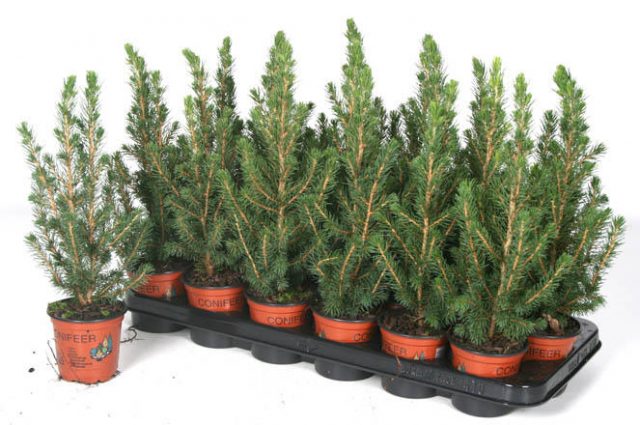

How to choose a plant
It must be remembered that if you grow a coniferous tree in a pot, then its height will be 15-30 cm, while in open soil, the height can reach 2 meters (usually about 170 cm). Therefore, if you decide to purchase a Christmas tree in a pot, the following factors should be considered:
- Pot size - if the pot is small relative to the crown of the tree, then the roots were cut off during transplantation. There is no point in buying such a plant, since it will die.
- Shoots at the ends of the tree - if in winter there are shoots at the ends of the spruce, then it was forcibly awakened. Soon the spruce will start to ache.
- Decorations - if the tree is decorated with something (shiny spray or varnish), then the tree will die, since the pores of the needles will be clogged with aerosol. (But you can try to wash it off with warm water)
- Trunk position - if the trunk is poorly fixed in the soil and moves, then it has recently undergone a transplant. You should not take such a plant, because the transplant could have been done incorrectly. The plant will die from this.Move the barrel carefully to check.
- The location of the roots in the pot - the roots should fill the entire volume of the pot, this will mean that the spruce has not been transplanted. To check, you need to dig out the soil a little, while note that it should be slightly damp.
- Frost resistance - frost resistance should be 1-2 values higher than your zone. Therefore, if you have a 6th zone, then you need to take spruce for 5 or 4 zones. Check with the seller for this information.
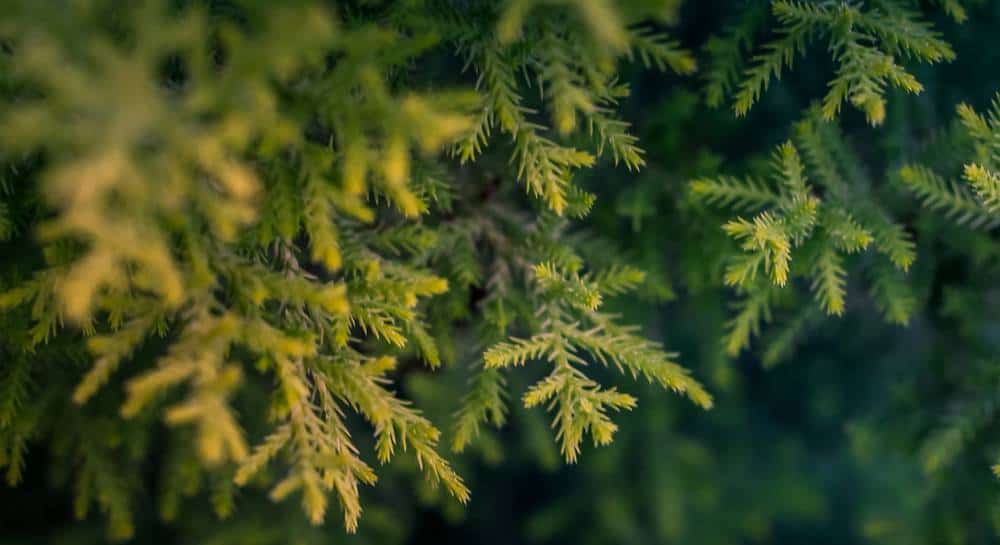

For the Russian climate in terms of frost resistance, the following are perfect:
- German common spruce
- dwarf fir
- serbian spruce
- conic spruce
- western thuja
- decorative blue spruce
How to grow a spruce
You can grow a Christmas tree at home in several simple and affordable ways for everyone.
- From a seed.
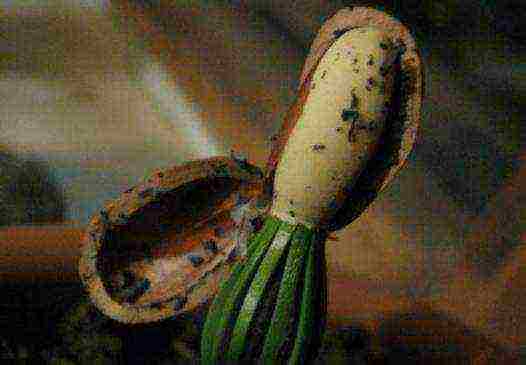

By growing your own tree from a seed, you are guaranteed not to break the law (after all, in some regions of the country it is forbidden to dig trees in the forest) and get a Christmas tree, almost from birth adapted to a new place of residence in your house.
What you need to do to grow a tree from scratch:
- Collect some mature buds of the desired type of spruce that have opened in natural conditions.
In autumn, somewhere in October, you need to go to the nearest park or forest and look for open cones with seeds in them under the trees. If you bring a closed cone home, it will also open, but the seeds in it may not be fully ripe.
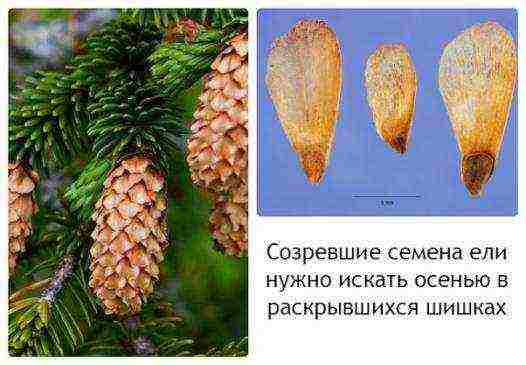

Fir-trees belong to gymnosperms and they arose much earlier than angiosperms (flowering) plants. Due to their characteristics, gymnosperms often displace other plants from the growing territory. The most striking example of such a neighborhood is Christmas trees and birches. At first, small spruces, loving moisture and shade, grow under the crowns of birches, then they grow taller than them, later they shade deciduous trees and acidify the soil, thereby finally destroying trees of other species.
- Plant the seeds in a pot and put it in a cool place (preferably a refrigerator) for a couple of months.
At all trees grow and adapt to absolutely any land from swamps to rocky soil, from sand to clay, but best of all, the spruce, of course, will grow on fertile black soil. It will also be important to add a little soil to the pot from under the spruce, under which you found a cone with seeds.
- After two months, when the seeds are ready to germinate, you should put the pot on a windowsill, on which it is not very hot and not too dark.
By the spring, your Christmas tree will be about 5 cm in size, and after two or three years it will reach a height of half a meter and will ask to be transplanted into the garden.
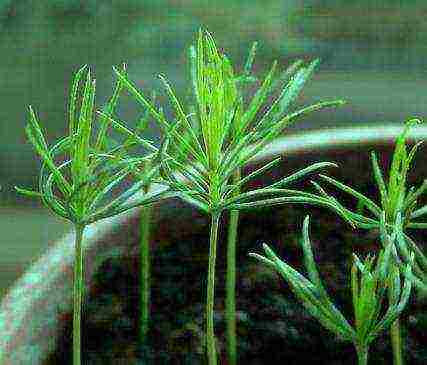

- From a seedling.
If you do not have the opportunity, desire or time to grow a Christmas tree from a seed, then you can immediately purchase a spruce seedling. It will certainly be a plant in a pot with a closed root system at the age of just two to three years, that is, ready for transplanting into open ground.
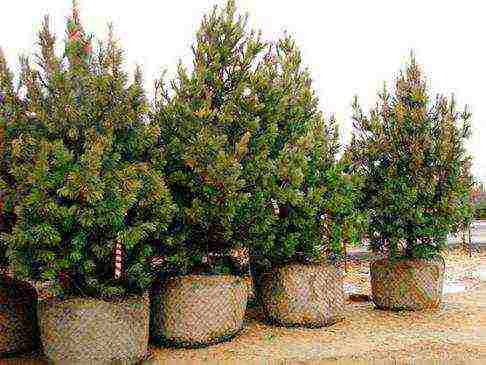

In recent years, it has become popular to acquire a spruce seedling just before the New Year in order to celebrate cheerfully, smelling the needles of a real live Christmas tree, and in the spring to transplant it into a park or forest.
Among the ancient peoples, the spruce was considered a sacred tree, they worshiped it, looked after and decorated it in every possible way. Having become Christians, the Europeans, nevertheless, preserved a number of pagan traditions, including decorating the Christmas tree, only now at Christmas. And Peter I, wanting that his state fully comply with European canons, introduced this tradition on the territory of Russia.
By choosing this way to celebrate the New Year, indeed, you can kill at least two birds with one stone: do not harm the environment, condoning the felling of trees for the sake of traditions, and contribute to the normalization of the ecological situation by planting a new tree in the spring.
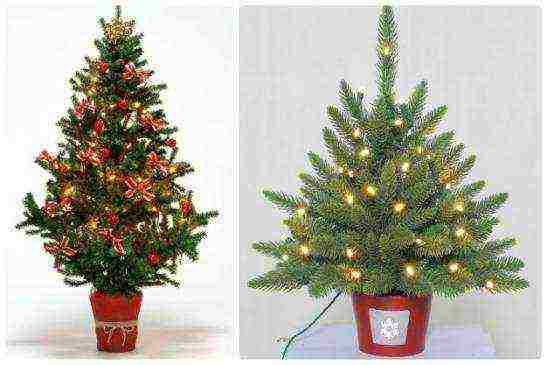

In order for the seedling to take root and feel good in the open field, you need to study the features of its existence until the moment it is in your hands.That is, it is better to select a tree for which you already have suitable conditions. In other words, if, for example, you want to have a Christmas tree in your yard, then the seedling should be chosen according to the conditions of your yard, and not hope that a two or three year old tree will be able to adapt to the changed conditions... This is extremely unlikely, and most likely, if the light and thermal conditions and the nature of the soil are too different, the Christmas tree will begin to hurt and may even die.
If the conditions for the "birth" of the tree and those in which you transplant it almost completely coincide, then all that remains is to immerse the tree in the hole exactly to the depth at which it was in the pot, and water in the event of a dry summer (about 10 liters of water in week during extreme heat).
- From a twig.
Another popular way, due to its effectiveness, to grow a Christmas tree yourself - from a twig or a cutting, as professional gardeners call it.
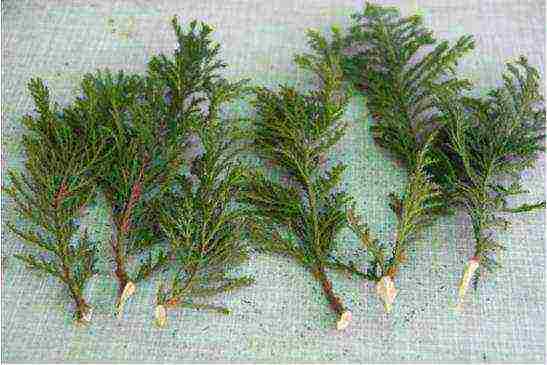

A twig about 20 cm long must be cut in spring or autumn from the top of a beautiful and healthy spruce, which is at least 5 years old, slightly cleaned of needles at the base and planted in the ground - in a pot at home or in a greenhouse on the street. In order for the stalk to be guaranteed to take root, you can soak its end for half an hour in a weak solution of potassium permanganate, and only then plant it in the ground. After planting, it is better to cover the stalk with a film and maintain the soil temperature at 21-26 degrees Celsius, and keep the air temperature at least 4-7 degrees. The first days before the roots appear, you need to water the newly-made seedlings several times a day, and then reduce the amount of water as they take root and take root in the soil. It is important to remember that Christmas trees do not like heat and direct sunlight, but they also cannot stand complete darkness.
For every sophisticated taste
Despite the variety of species of this plant, only a few are grown at home.
The most popular varieties of asparagus include the following:
- Pinnate looks like a branching bush and is more like a fern than any other species. It has thin branches, sometimes more than a meter long, and black and blue poisonous fruits. Although at home it blooms, which means it rarely bears fruit. Of all the plant species, this one is the most shade-loving, it can even grow completely under artificial light. But still, in winter, it is better to move the plant closer to the window.
- Dense-flowered or asparagus Sprenger very spectacular beautiful plant with small needle-leaves. Its long branches descend like vines, so it is better to plant it in a pots. This species bears fruit, its bright red berries look original in dense greenery. It is one of the most thermophilic species of indoor asparagus and does not tolerate temperatures below 15˚.
- Ethiopian (Meyer) among amateur flower growers it is less common than the first two species, although its long fluffy stems look very elegant. The fact is that this species is demanding on the temperature regime and does not tolerate temperatures below + 12˚ and above + 18˚ poorly. Therefore, it is grown more often in winter gardens, greenhouses and glazed loggias.
- Crescent native to the mountain forests of India. It is not even a shrub, but rather a fast-growing vine that can reach 6 meters in length. It is called so due to the fact that its leaves (cladodia) are sickle-shaped. This species is quite unpretentious and does not tolerate only hot sunlight and too cold temperatures.
Here is what a pinnate asparagus he is - a selection of photos of a handsome man:
Care
The features of care will vary depending on the ephedra you choose. For example, the cypress tree does not tolerate direct sunlight. To protect the plant from needles burns, it must be placed in a darkened place. Agree, a cypress tree with scorched tips of needles is not the most beautiful decoration in your home, right? If you cannot provide such conditions, it is better to refrain from purchasing this plant altogether.
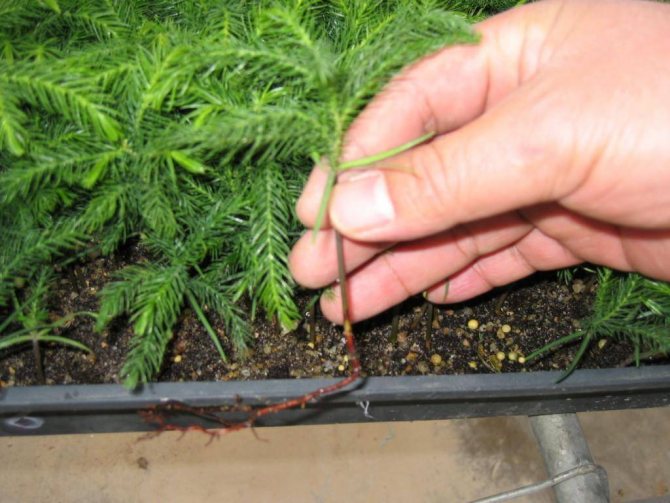

As for watering, there are many indoor flowers, the soil of which needs to be moistened only after it dries noticeably. But this does not apply to such a home tree as cypress: it needs to be watered at least once a week. This plant also responds favorably to spraying.In this case, do not be afraid to overdo it, because there is never a lot of moisture for a cypress.
What should be the top dressing? This again depends on the type of coniferous plant. For example, araucaria requires constant fertilization. Moreover, you should not oversaturate the soil with minerals, which contain a lot of calcium. It is better to dilute fertilizers in several times in reduced doses than indicated in the instructions.


Ephedra in general are quite whimsical in their care, therefore, before deciding to purchase them, think about whether you can provide an optimal microclimate for their development. In any case, conifers are beautiful and fragrant perennials that will certainly decorate your home, so your efforts will be rewarded.
Comments (7)
Irina Vitalievna
01.04.2018 at 00:11 |
We tried to grow a spruce with our own hands from seeds and even by cuttings, but we did not succeed. We decided not to grow from scratch anymore, but came to the nursery and bought ready-made plants in pots for 2-3 years.Reply
Expert Fruit
19.08.2018 at 21:39 |
Good afternoon, Irina! Most likely, your seedlings were affected by the "black leg". This fungus is a malicious pest of young plants growing on black soil. Therefore, I want to offer you a method of getting rid of this scourge.
Take soil for conifers from under adult plants of the same species. After sowing the seeds, sprinkle the soil with calcined river sand, 0.5 cm thick. In this case, the risk of damage to seedlings by the "black leg" will be minimal!))
Reply
Marina
02.04.2018 at 00:16 |
If I understand correctly, then the type of the Christmas tree should be different from the way it grows on the street. Otherwise, I can't imagine how to grow such a tree at home, it will take up a lot of space.
Reply
Expert Fruit
13.09.2018 at 12:05 |
Hello Marina! Nowadays, in the garden centers there is a huge number of a wide variety of conifers. Among them there are those that grow well at home. For example, bred on the shores of Foggy Albion, the cypress "Goldcrest Wilma". In addition, do not forget about the Japanese culture of creating bonsai (dwarf trees that successfully grow in greenhouses). You can read more about this in Leila Dhanda's book "BONSAI Culture - Growing Dwarf Trees".
Reply
Julie
01.07.2018 at 12:33 |
But we have a tree growing, while the truth is very small. We found her in the park, under another huge tree. I don’t know from what it grew there, maybe from the seeds of a cone. The fact is that the paws of a large Christmas tree did not allow it to grow at all. And after permission to carefully dig it up (and we literally dug it out with a penknife), the Christmas tree was transplanted into our garden. Now she is about 30 cm, beautiful and green. We will definitely decorate it for the New Year.
Reply
Olga
29.07.2018 at 08:07 |
I remember our New Year tree was giving roots. So they threw them out. She stood in the water for a couple of weeks, water was topped up regularly. I wonder if if she were planted with these roots, would she take root?
Reply
Expert Fruit
13.09.2018 at 12:38 |
Good afternoon, Olga! If your spruce has given roots, that's great. But in order to plant it in the ground, you would have to book all the branches, "I can’t at the most." The fact is that in plant growing there is a formula according to which the diameter of the crown (when transplanting) should be less than or equal to the diameter of the root system. This is necessary so that the seedling can receive enough nutrients to nourish the crown. As for your spruce, unlike hardwoods, there are very few dormant buds in the tiers of spruce branches. So, in your case, you could get a spruce that is perfect for forming a Harm Resist bonsai from it. However, I have good news for you. The fact is that a plant capable of giving roots transfers its characteristics to its vegetative offspring (read about the technique of coniferous cuttings). If in the first generation of cuttings, out of 100 units, 2-3 pieces will take root - this is already good! Cuttings taken from these seedlings can show an efficiency as early as 40%. The third wave of cuttings is capable of bringing out a plant in which 100 cuttings out of 100 possible take root.So - Go for it! The road will be mastered by the walking !!!
Reply
Seasonal cultivation features
Caring for asparagus in summer and in the cold season is different, since winter for almost any plant is a dormant time.
Summer time
In summer, watering should be as abundant as possible - twice a week. It is not scary if water accumulates in the pan.
Of course, it is impossible to flood the plant, as this will cause rotting of the roots. In summer, it is also recommended to spray the flower once a week, this also helps to humidify the air.
If the room is sunny, or the windows face south, then you need to take care of the shading of the asparagus. It is better to transfer it to the summer time away from the sun.
In the warm season, plants can be taken out onto a balcony or open loggia, but only if there is a shade there.
Features of winter care
Winter for flowers is a dormant period, and watering should be reduced to once a week, preventing the soil from drying out. In February, when young shoots begin to appear on asparagus, watering can be increased.
Spring - transplant time
Since asparagus grows quickly, it is recommended to replant young plants once a year, and those that are older - after 2 or 3 years.
To do this, choose a more spacious pot and fill it with fresh soil mixture. During transplantation, you should carefully examine the roots of the flower and cut off diseased and decayed ones.
It is recommended to separate strongly overgrown plants during transplantation and place them in different pots.
Seat selection
The intensity of their growth, and in some cases, survival in general, depends on how successfully you provided the conditions for the life of conifers. Despite the fact that conifers seem to like a temperate climate more, many of the varieties of this group of plants are of tropical origin. Pay special attention to choosing a place for a flowerpot with an ephedra, moreover, in the winter.
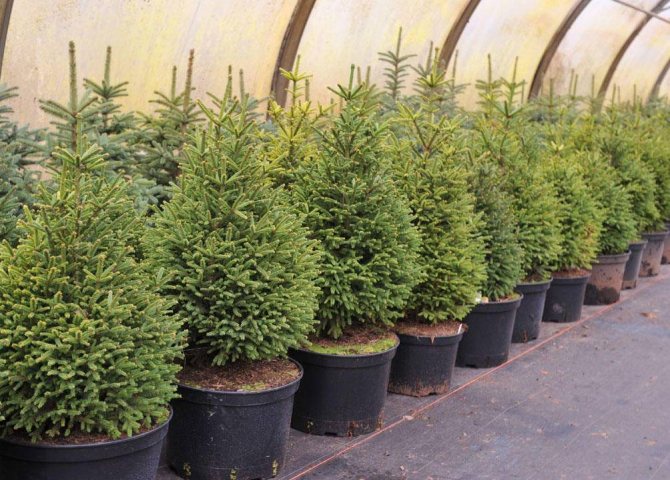

The thing is that in winter we actively heat our houses and apartments, and since hot batteries are mainly located near windows, the window sill is not the best place to grow a home coniferous tree.
Hot air, in the absence of proper moisture, undoubtedly has a detrimental effect on this kind of shrubs and trees. But if there are no other places for conifers in your home, a window from the north or northeast side will do.
Nevertheless, the glazed loggia, balcony or terrace is the optimal area for the growth of coniferous trees. It is undesirable to take the plant outside in cold weather.
Can you grow your own spruce?
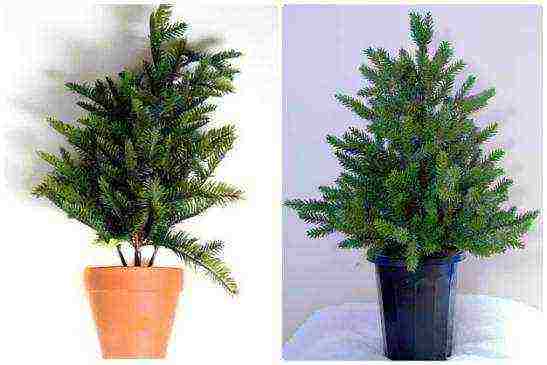

As a New Year's, in principle, any plant can become, at least from a distance resembling a coniferous, for example, cypress or boxwood. For those who are not looking for easy ways and strive to achieve perfection in everything, it's time to study the question of how to grow a Christmas tree at home, because this is more than real!
The biggest difficulty in growing a Christmas tree at home is the limited ability of a city apartment to provide a so-called dormant period for the spruce. If you pay attention to the life cycle of an ordinary forest tree, it is not difficult to notice that during the year the temperature regime that it has to endure varies from +30 heat in the summer to frost - 30 in the winter months. Fir-trees easily tolerate such temperature changes throughout the year, moreover, these conifers are perfectly adapted to them, and violation of the temperature regime only leads to diseases of the firs.
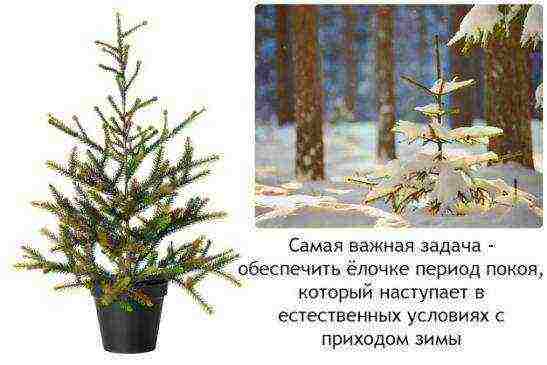

That is why it is better to start growing a Christmas tree in an apartment if there is a loggia or other cold and cool place. You should also be prepared that in two or three years the tree will have to be transplanted into the natural conditions of the forest, because in nature spruce trees reach a height of several tens of meters, and for a tree of such dimensions, of course, neither a pot of earth, nor even the largest size is enough rooms.
On average, spruce lives for about 300 years, but sometimes its age can be up to 600 years. The oldest Christmas tree on Earth is now almost a thousand years old, and it grows in Sweden. "Old Tikko" - this is the name of the tree - lives and lives in Fulufjellet National Park and is revered as the oldest arboreal organism on the planet.
Why does he get sick and die?
The causes of flower disease are the same as in most indoor plants: overflow or insufficient watering and pests.
In winter, the plant is badly affected by excessive moisture, and in summer its lack. Direct rays of the sun can also cause drying and shedding of plant shoots.
The most dangerous spider mite for domestic asparagus is a real problem for many gardeners.
It is too small to be noticed immediately and difficult to get rid of. Moreover, spraying with substances that kill the pest can destroy the plant itself.
What is the use of spruce in the house?
Everyone knows that coniferous plants release into the environment a lot of useful substances that contribute to the fight against a large number of diseases, soothe, have a beneficial effect on the cardiovascular and nervous system, and spruce needles are no exception. It is no coincidence that most of the sanatoriums are located, as a rule, in coniferous forests. We have the following materials about the benefits of conifers: The use of needles in cosmetics | The benefits of coniferous forest and a separate article on the benefits of spruce.
Growing a fir tree indoors is not at all difficult, and it will always delight you with its unusual beauty and pleasant aroma. And during the winter holidays, it can become the main decoration of your home, of course, if you take proper care of it.
Another interesting article on growing unusual plants at home: Growing myrtle
In recent years, purchased Christmas trees have had alternative options. A good half of gardeners have already appreciated the advantages of decorative Christmas trees, which delight with a fresh aroma and refresh the air in the house, and then on the site. This is the main advantage of miniature beauties who feel good indoors until spring, and then move outside. Conifers in containers are not monotonous, buyers usually have a lot to choose from. True, in this case it is necessary to take into account the characteristics of a particular variety, which will be correctly designated in any nursery.
Types of spruce
For those who decide to grow a Christmas tree at home, it is better to pay attention to such unpretentious and inexpensive species as common spruce or prickly spruce. Serbian spruce is very hardy, its dark green needles are highlighted with silver from below.
When you click on the picture, it will increase!
| Norway spruce | Spruce prickly |
| Serbian spruce | Serbian spruce |
There are dwarf types of spruce: Canadian spruce Conica (ten-year-old plant height about 50 cm) or common spruce Nidiformis (30 cm), which can fit in an apartment, but their appearance is somewhat different from the traditional one.
| Canadian spruce Conica | Norway spruce Nidiformis |
Breeding spruce cuttings
Before planting cuttings, you need to prepare a nutritious soil. The stalk is best cut from a tree that is 6 to 9 years old. It is necessary to take a one-year-old twig from above. Clean the tip of the needles, put it in a weak growth stimulator for 5-10 minutes and then transplant it into the soil at an angle of 30 degrees. Cover the planting immediately with foil. Cuttings are planted only in spring or autumn. Watering the seedlings should be carried out as the soil dries up. We must not forget about fertilizers.
Trees grown from cuttings take root much faster, but at home they will not last long, and after that they will have to say goodbye to homemade spruce, since for its normal existence it is necessary to plant it on the site.
Diseases of conifers
Coniferous ornamental plants susceptible to infections, but early detection of their signs and immediate treatment will help avoid dangerous consequences.
- Rust. It manifests itself as orange blooms on the branches.The needles turn yellow and crumble. Weekly crown treatment with drugs such as Glyocladin and Vectra will help.
- Schütte's disease is caused by a fungus. Signs: the needles are covered with a white bloom, darken and crumble. If you do not start the situation, the plant can be cured by first spraying it with a solution of copper sulfate, then treating it with Alirin-B and Trichodermin.
Reproduction methods
Young home tree
The plant reproduces in two ways:
With the help of seeds. In order to grow a forest beauty from seeds, you must use pre-harvested seeds from spruce cones. They are collected from mid-October to the very end of winter.
In a flower pot, seeds are sown not at all deep: about 1.5 cm to the edge of the soil surface. During the rooting period, the container is placed in a cool place. After a year, the seedlings will reach a height of 15 to 25 cm.
Using cuttings. According to experienced gardeners, cuttings up to 12 cm long are considered ideal for planting.
On the lower part of the cutting, there should be a "heel" or a convex part of the bark, due to which the development of the root system of the new plant will take place.
It is important to bear in mind that the minimum length of the cutting is 6 cm. Cuttings are prepared in mid-spring. At this time, sap flow begins in the coniferous plant. This indicates that it has completely recovered after a long winter and is saturated with valuable substances necessary for development.
When propagating a Christmas tree by cuttings, a substrate is used, which includes universal soil, peat, sand and perlite.
After planting, the cuttings are recommended to be covered with a special polyethylene film for a week. At the same time, it is important to take into account that air practically does not penetrate under the film, and therefore, it should be regularly opened and young plants should be allowed to ventilate.
Using the above methods of plant propagation, you can grow a beautiful decorative spruce on your windowsill.
Transplanting spruce from the forest
How to grow a Christmas tree in a garden if you don't have time to mess around with germinating seeds or cuttings?
The solution is simple: plant an adult copy on the site. You can get it for free if there is a coniferous grove next to the house. Attention:
taking spruce from protected areas and other protected areas is prohibited.
The transplant procedure is best done in early spring or in autumn, when moderate, cool weather sets in the yard. The landing site is prepared in advance
... Even a small seedling will eventually grow to a height of 7 to 10 meters and develop a spreading crown about five meters in diameter. Remember this and do not dig a hole near buildings and light-loving plantings.
In spruce, the root system does not extend in depth, but in breadth and significantly depletes the soil. In addition, strong roots can undermine the foundation. Planting a tree next to electrical or gas pipelines is also a bad idea. The ideal distance from residential and commercial buildings is 15 meters or more.
The dimensions of the hole to be organized should be at least 70x70 cm. A thick layer of drainage is poured onto the bottom. The hole is lightly watered so that the soil at the bottom is soaked. In such conditions, the seedling feels better. Fallen needles tend to oxidize the soil
... If you do not plan to rake them in a timely manner and remove them outside the territory of the site, it makes sense to organize nearby flower beds of plants that love soil with high acidity: these are lupins, hydrangeas, purslane, nasturtiums, poppies, etc.
When choosing a tree for transplanting, look for a small specimen no higher than one meter with an even crown and a proportional arrangement of branches. Do not take broken or stunted trees, such a sample is unlikely to take root. Please note that the spruce on the site should be determined in the same direction in which it grew in its natural environment (in the direction of the south, north, etc.).The tree is dug in from all sides, leaving the root system in an earthen cube of sufficient volume.
Wrap the bottom of the trunk together with a lump of earth in a cloth and deliver it to the site. Do not forget to collect a bucket of soil from the hole where the plant was located: it is poured into a new hole for faster adaptation when replanting.
The spruce is installed vertically in the dug hole. Make sure the barrel is level
, and sprinkle it with soil. The planting circle is watered and mulched with wood chips or straw. For the first weeks, the seedling is watered often enough to keep the substrate moist. It is useful to shade the landing with an awning. When the tree gets stronger, maintenance is reduced to a minimum.
Canadian spruce at home is not easy, but still possible. But do not forget that under natural conditions, a spruce is a large tree, so it cannot be planted in a pot forever. And no matter how much you want to part with your pet, it is recommended to plant a tree in natural conditions until the age of 3.
The most famous types of indoor plant araucaria and photos of these species
To date, nineteen plant species are known. The most famous and common varieties of araucaria include the following.
Norfolk is considered the homeland of the variegated araucaria. It is an elegant tree with a pyramidal crown, and in natural growing conditions reaches sixty meters in height. The half-naked trunk of an adult tree can be over a hundred centimeters in diameter. Araucaria has a variegated dark brown scaly, resinous bark and light green soft, pointed, small (up to eight millimeters) foliage. The plant is well suited for growing in city apartments, offices and greenhouses.
The natural habitat of the narrow-leaved araucaria is southern Brazil, where it can reach fifty meters in height. The tree is characterized by slender and drooping branches with linear-lanceolate bright green leaves that are no more than five centimeters long.
Columnar araucaria can be found on Pine Island in New Caledonia. The majestic trees have a narrow pyramidal crown formed by short branches that extend at right angles from the trunk. They cover the plant from the very base to the top. The buds grow up to ten centimeters in length.
The natural habitat of the Chilean araucaria is Chile and western Argentina. It is a fairly large tree, reaching sixty meters in height, and having a trunk up to one and a half meters in diameter in an adult state. Young trees have a wide pyramidal crown with lower branches lying on the ground, which fall off as the tree grows. In adult specimens, the remaining branches are collected in whorls and are horizontal or slightly hanging. The tough and thorny dark green foliage has a spiral arrangement. Local residents consider Chilean araucaria a valuable tree, its wood is used in construction, and the seed is used in food. It is also grown for decorative purposes.
Caring for decorative spruce on the site
A coniferous plant after transplanting does not require much attention and time. No need to do an additional transplant, pruning.
If the summer is moderately dry and hot, the tree has enough natural precipitation. But in a particularly sultry season, watering will be required at least once a week. In this case, it is advisable to spray the crown with water.
Topsoil can form a dry crust. Careful loosening will be required.
During the first two years, measures should be taken to protect the ephedra from possible severe frosts. To do this, in late autumn, a mulching layer must be laid around the trunk.
In spring, there is a threat of sunburn. This can be seen by the brown color of the needles.To avoid injuries, experienced gardeners in early spring wrap the tree trunk with a material that scatters light and at the same time allows the plant to breathe.
The origin of the curiosity
There are more than 200 species of asparagus, but only a few of them are grown as indoor decorative flowers. This plant is essentially asparagus, despite the fact that it sometimes resembles a fern.
Shoots of some asparagus species are even edible, just like regular asparagus growing in the garden.
Asparagus is a perennial plant with long branches that resemble vines. The form of leaves from him is taken by shoots - cladodia.
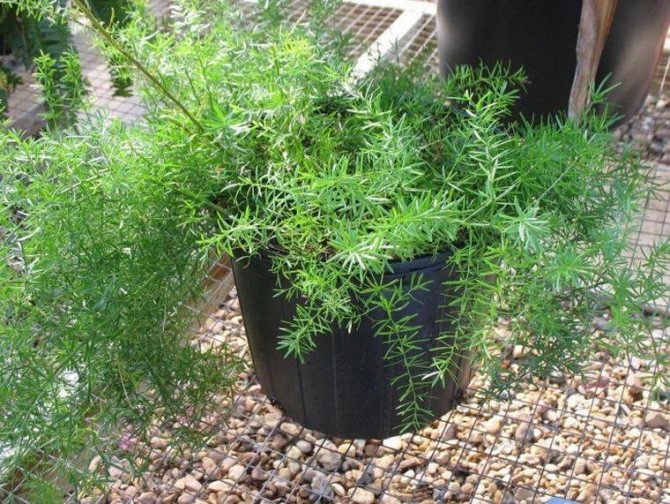

It is these needle-shaped formations that give it such an attractive decorative look and make it look like an unusual herringbone with soft needles.
This plant blooms with small, nondescript, albeit pleasantly smelling flowers. But small bright red or dark blue berries look original in the green of asparagus and decorate it very much.
Asparagus is native to the subtropical forests of the Mediterranean, Asia and South Africa. Therefore, the plant is thermophilic and does not feel well with a lack of moisture.
True, some of its species may well winter outdoors in a fairly cool climate.
Description
If you are looking for a herringbone-like houseplant, ephedra is the best choice for your home. And not only during the New Year holidays. Such a mini-tree will be an excellent gift for both a beginner and an experienced florist. In addition, not everyone has the opportunity to do gardening, grow flowers and the same conifers near the house. But indoor conifers take root well indoors.
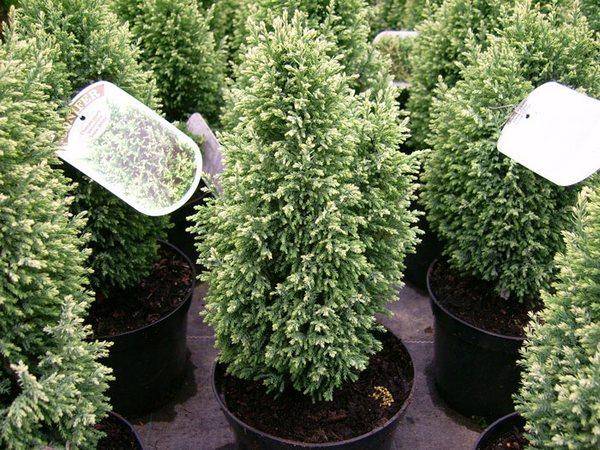

Nevertheless, such an evergreen decoration for an untrained grower can be a real problem. Along with the key advantages, ephedra are also very demanding on lighting and location. If you want them to be comfortable in your home, it is worth equipping them with a kind of winter garden. The first thing to ensure is a constant supply of daylight. The optimal place for conifers is a glazed balcony, loggia or terrace.
In doing so, remember that sunlight should be diffused, as direct rays harm the plant. Very often, flower growers make a mistake, choosing an open area for the growth of coniferous mini-trees, for example, a non-glazed terrace. Despite the fact that you purchased a coniferous tree, during the period of severe frosts, the soil in a flower pot may simply freeze, and then you will not save the plant from death.
Caring for conifers cannot be called a simple occupation: here it is required to humidify the air in time, and to acquire special lamps to illuminate coniferous trees when they do not receive natural light. But with every effort, you will achieve amazing results, and conifers will decorate your house or apartment for several years.
Let's add a little scent to our flower garden ...
You always want the yard to please not only with its beauty, but also with spicy tasty aromas. Therefore, when choosing a "perfume" for your flower bed, pay attention to the following plants:
1. Lavender is remarkable not only for its scent, but also for its soothing properties. After flowering, you can cut it off and dry it, and then make decoctions that save you from insomnia, or simply put odorous twigs under your pillow. This biennial plant is successfully used in the design of various parts of the garden, rock gardens, ideal for creating borders.
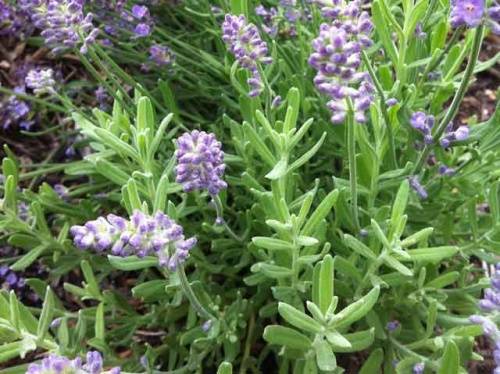

Lavender is planted with islands or an uneven curtain, so as not to disturb the naturalness of the mountain landscape.
2. Mint and lemon balm - connoisseurs of delicious tea simply cannot do without planting these fragrant plants. However, it should be noted that mint grows very quickly and can turn into a real weed. To prevent this from happening, dig a fence made of ordinary rubber 40 cm into the ground.Since the mint roots grow horizontally rather than in depth, this will limit the space for growth.


A distinctive feature of the varieties of lemon balm is a pleasant lemon scent ...
3. Sweet pea - This curly annual flower grows much better in the shade, and loves moist soil. You also need to install a small metal grate to which he will cling with his antennae. Flowering begins in June and continues until frost.
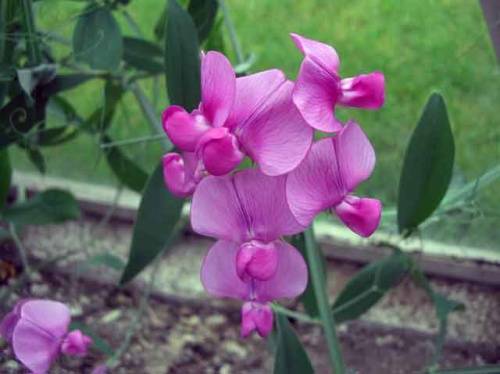

The main charm of sweet peas lies in the bizarre flowers and all kinds of colors, reminiscent of bright butterflies.
4. Night violet - it is also called: hesperis, Matrona's nocturnal or simply nocturnal (Latin Hesperis matronalis). This flower emits a surprisingly pleasant heady aroma mainly in the evening, so this plant is recommended to be planted by everyone who likes to spend time staring at the starry night sky.
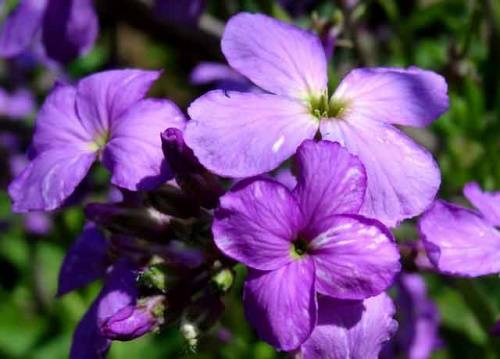

For some resemblance to phlox, Matrona's nocturnal is called in a number of places a not quite euphonious name - “bull phlox”.
5. Lobularia (alissum) - this garden plant with a wonderful honey scent spreads beautifully along the ground, creating a surprisingly bright carpet of white or lilac flowers. Also, alyssum can be planted in a pot, and the flowers will descend from it, like a petunia.
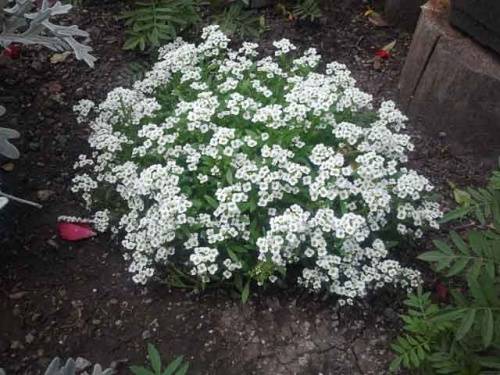

Lobularia has another name - stonemason, as it grows beautifully and looks in rockeries, hills, between stone slabs and even in cracks in masonry.
In fact, it is very easy and inexpensive to make a beautiful, fragrant and healthy flower bed, the main thing is to approach the matter with soul and imagination.
see "Alpine slide in garden design"
Araucaria (lat. Araucaria) - an evergreen coniferous tree-like plant with tiered branches (beautiful pyramidal crown). Araucaria varifolia is the only species sold as a coniferous houseplant. Indoor araucaria in a pot can replace a Christmas tree for the New Year.
Leaves: needles, the length of which reaches 1.5 cm, young needles are light green, but with age they become darker.
Flowers: cones on araucaria do not appear at home.
Location: loves bright rooms, but in the summer you need to protect the araucaria from direct sunlight.
Watering: Araucaria should be watered abundantly once a week in winter. In the summer 2-3 times a week.
Air humidity: keep the araucaria away from heaters in winter and spray the plant every 2 days. In the summer, it is necessary to ventilate the room.
Transfer: while araucaria is young, they transplant it every 2 years, they do it in February-March. When the araucaria reaches a height of 1.2 m, it will need to be transplanted every 3 years.
Land: greenhouse, but it should not be too dense, with the addition of high-quality organic fertilizer. The substrate can be prepared in the following proportions: 1 part of sod land, 2 parts of leafy soil, 2 parts of peat, 1 part of sand. Indoor araucaria also need good drainage.
Top dressing: 20 liters of diluted granular delayed fertilizer for the season.
Reproduction: seeds or cuttings, but only professionals can do it. Only the tops of actively growing young shoots are suitable for cuttings, they are cut with a sharp knife in the middle of the internode and allowed to dry for some time. Araucaria is cut at the end of August, when the shoots are firm. Cuttings are planted in separate pots with coarse sand. In September, they are transplanted into pots with a substrate for adult araucaria. You need to keep them in a bright place at a temperature of +5 - 10 C.
Araucaria seeds are planted ½ the length with a sharp end in the ground. Cover with moss on top, while maintaining it in a moderately moist state. Sprouted araucaria seeds are carefully dived and placed in a bright place, protected from direct sunlight.
Dimensions: in a pot, araucaria grow up to 3 m, in the natural environment - 50-60 m.
Life Span: in a pot for up to 10 years, if conditions are good.
Pests and diseases: red spider mites and worms, if the air in the room where the araucaria grows is too dry.
Special Requirements: provide support for the barrel. Araucaria also does not tolerate the heat in winter, dry air harms it, so the temperature in the room where it grows should not be higher than 15 C.
Content tip: if araucaria receives nitrogenous fertilizers, it forms impressive internodes, which breaks its silhouette. Therefore, use a special fertilizer for conifers and divide the dose recommended on the package into 2 parts. Also, araucaria can shed leaves and lower branches, this usually happens when the temperature is too high and the air is dry or the earth dries out.
Application: This indoor plant in a pot can replace a Christmas tree for the New Year. Young plants can be used to decorate the table, older tall trees can be placed as decoration in the hallway and large room.
Beneficial features: araucaria secretes phytoncides, very few houseplants have this property. She also has a favorable energy.
Every spring, pale stems stick out in places among the growing forbs, similar to densely spaced arrows. These are horsetails - plants are mysterious and unusual. Indeed, no one observed flowers on horsetails; the stems of some species change twice during the season. At first, in the spring, arrows with brown tips grow (popularly referred to as ostysh), and a month later they are replaced by green Christmas trees, which do not wither until late autumn
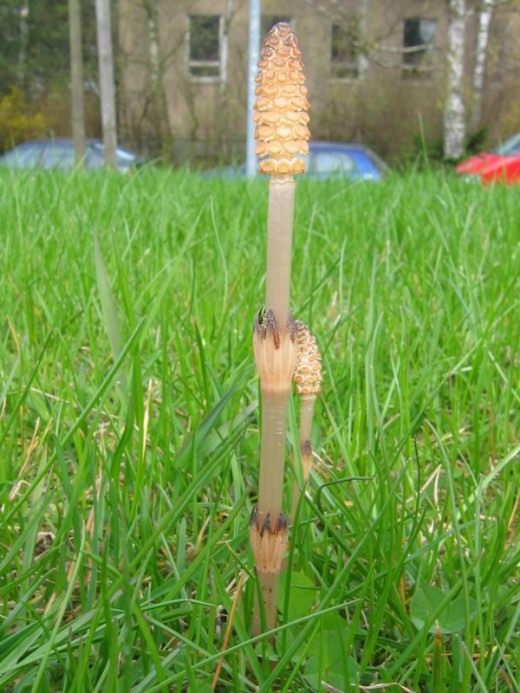

Field horsetail (Equisetum arvense)
With its rapid reproduction, this plant gives gardeners a lot of trouble. In addition, it is difficult to fight horsetail: you cannot remove it by plowing - the roots lie deep, but a breakthrough takes a lot of time and also does not completely cleanse the crops. And yet, these measures and fruit change prevent the weed from accessing the furrows and ridges. In general, horsetail is an indicator of acidic and waterlogged soils. Liming and draining the area will help get rid of horsetails.
Horsetail herb, rich in valuable medicinal substances, has long been recognized by medical practice as a diuretic for diseases of the kidneys and bladder, as well as an agent that improves blood circulation. Horsetail and old wounds are treated. In this case, use herbal lotion or baths. With sore throat and inflammation of the gums, it is also useful to resort to horsetail infusion: two tablespoons of the herb are kept in a glass of cold water, rinse the mouth or throat with the strained liquid. Field horsetail has also proven itself in home cosmetics. Compresses from its infusions and decoctions are especially beneficial for strengthening hair, with inflammation of oily and porous skin.
Only summer-green horsetail herb is prepared for medicinal purposes, spore-bearing arrows are not suitable for collection, like all extraneous types of horsetails: meadow, forest and marsh. Let's remember their signs. The meadow horsetail is rough, hard, its stems are grooved, the branches are arranged horizontally or even bent downwards. Its forest counterpart also has branches down and a grooved stem. The marsh horsetail is tall, its stem is almost as thick as a little finger, a spore-bearing spike can be noticeable above the upright branches. Horsetail grass feels soft to the touch, with tetrahedral sharp twigs pointing upwards.
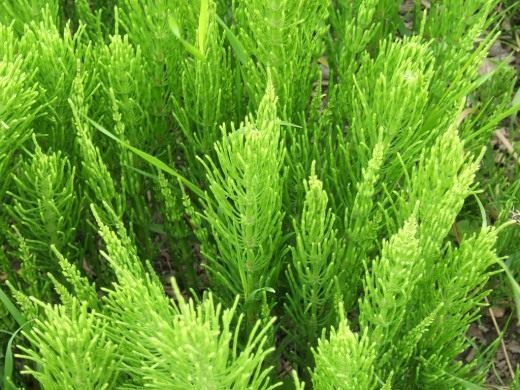

Field horsetail (Equisetum arvense)
<>
Horsetail is dried in attics or under a canopy. The finished raw material is a mixture of gray-green grooved stems with twigs. The smell, though weak, but peculiar, the taste of the grass is sour. They try to avoid chopped stems in the raw materials. Shelf life in a dry place is four years.
Let's talk about the nutritional value of horsetails, especially since there is an opinion that they are all poisonous.Yes, some horsetails justify the suspicion of toxicity in full, especially for those species that contain alkaloids (for example, marsh). Frequent giving of horsetail hay causes paralysis of the hind limbs in horses - "connecting rod". The disease, by the way, soon ceases if poisonous food is no longer pitted. As for the horsetail, of all the bristly counterparts, it is the least dangerous to animals. Indeed, it contains almost no alkaloids, and saponins, as poisonous elements, are of very weak action. In any case, this horsetail is not poisonous for cows, sheep and goats, on the contrary, in some northern areas it is not without reason considered a milk-producing fodder. It is better for horses not to give this horsetail either.
It is interesting that when grazing, cattle almost do not suffer from horsetails, although they are collected fairly in order to quickly restore strength and fatness.
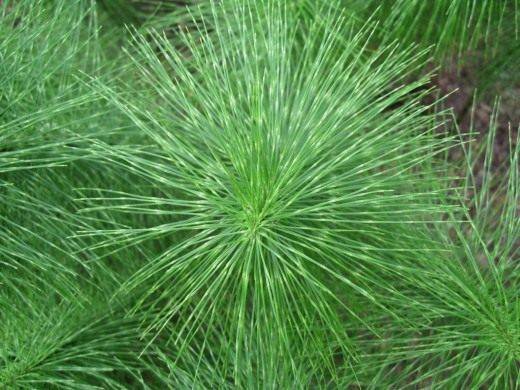

Horsetail (Equisetum telmateia)
<>
This is simply explained: other green herbs seem to soften the active principles of a poisonous plant, have a laxative effect on the body. Moreover, horsetails are not equally poisonous in all phases, they are most dangerous at the age of young "pines". Usually, animals easily recognize local poisonous plants and try to bypass them, which, unfortunately, cannot be said about imported livestock, especially from areas where the composition of grasses is completely different. Horsetails are not afraid of spring grazing, they are more oppressed by summer regular grazing.
In addition to medicinal and food value, the horsetail also had some domestic use. Once upon a time, with its hard stems, they cleaned smoked dishes, polished wood and stone, and dyed wool in gray-yellow tones with a decoction from the roots collected in spring. Green dye was extracted from the stalks of the marsh horsetail, popularly nicknamed iron ore. In some places, tender pushers - spikelets - were eaten as vitamin greens. By the way, horsetails and nodules growing underground are edible, because they are rich in starch.
In historical terms, horsetails are the most ancient representatives of terrestrial vegetation. Their distant ancestors were giants, together with mighty ferns, they formed deposits of coal. Now, looking at the green bristles of the grass, one cannot imagine the powerful horsetail forests.
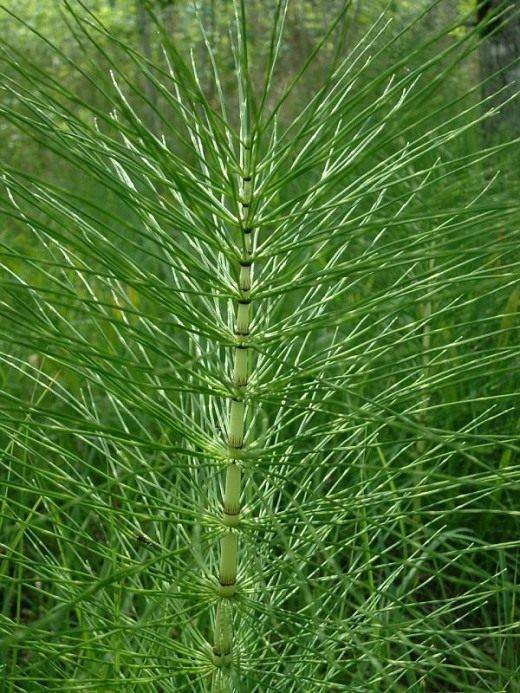

Meadow horsetail (Equisetum pratense)
Horsetails are found on all continents, with the exception of Australia. The species diversity of plants is small - there are 25 species all over the world, of which about half are found within our country. Horsetail is popularly known as a Christmas tree, earthen cones, pestushki, pigs and streams. The scientific name in translation means "horse's tail". The branchy grass, indeed, vaguely resembles a ponytail, especially when the erect branches are lowered with their ends down ...
Links to material:
Based on materials from the agronomist A.
Traditionally, we decorate our homes for the New Year with coniferous trees - spruce or pine. But it is not always possible to put a tree at home - there is not enough space, small children, and sometimes it’s just a pity that a beautiful tree, which has been growing for many years, is cut down simply in order to stand for a week in human housing and be thrown away as unnecessary. Recently, artificial Christmas trees are becoming more and more fashionable. They are, of course, beautiful and comfortable, but still not alive. Let's think about what kind of living plant you can replace the traditional Christmas tree.
Plants for replacing the Christmas tree
Araucaria
The simplest and most affordable plant for these purposes is araucaria. This is a tropical herringbone that can be grown at home without any problems as a houseplant, dressing up for the new year. Unlike a regular Christmas tree, araucaria has lighter and silky needles to the touch, which makes it also a very pleasant indoor plant.
Boxwood
Boxwood can be a good substitute for a Christmas tree. It is usually grown in gardens and parks as an ornamental shrub.He easily tolerates a haircut, thanks to which it is from him that living garden sculptures of topiary are made. If desired, the bush can be given a conical shape, making it look like a spruce. Boxwood can be grown at home, only it does not like the bay and in winter in a warm room it needs as much light as possible. And for the summer, you can plant a green bush in the garden or decorate your balcony with it. For the winter holidays, this green fluffy bush can easily replace the traditional Christmas tree.
Indoor cypress
Another coniferous plant may well grow in the apartment - cypress and its closest relative, cypress. It is usually sold in the form of small bushes or an elegant tree with light green needles. You can buy it at any flower shop. But since it is hot for him to spend the winter in an apartment, the plant should be put in the coolest and brightest place in the house after the holidays. If there is no cool place, it should be sprayed regularly. For the summer, the plant can be placed in the garden or on the balcony.
Thuja
Another plant that can replace a Christmas tree may be thuja. It can also be grown on a cool window and dressed up for the new year.
Juniper
A wonderful Christmas tree can be obtained from a juniper. This wonderful coniferous plant also has a very pleasant smell, which will bring special new notes to the aroma of the holiday. Only a juniper for these purposes must either be grown from seeds or bought in a store - dug up in the Crimea or in the Caucasus, the juniper does not grow in room conditions.
Potted spruce
You can decorate the festive interior of the house with a real live Christmas tree growing in a flowerpot or container.
Recently, more and more often they began to offer to purchase not felled spruce, but planted in a container. Subsequently, it can either be handed over back to the forestry, or planted in the garden. When purchasing such trees, you need to make sure that the clod of earth in which they grow is not frozen. If you buy a small Dutch Christmas tree from the store, don't buy plants that have been doused with snow spray or glitter - these plants usually don't survive.
Spruce in a pot or container in a warm room can be kept for no more than 7-10 days. Since, due to the heat, the spruce can wake up from hibernation and start growing. If the tree still begins to grow, it is no longer possible to take it out into the cold. The plant should be placed in the coolest, but not freezing place and left until spring. Spruce can be planted or dripped with a container until next year only when the temperature in the place where it is kept equals the outside temperature. If you put the plant on a freezing loggia, be sure to wrap the container well so that the earthy ball does not freeze.
You can stock up on a Christmas tree in the fall - buy a good healthy container plant in a horticultural economy, bury the container in the ground and sprinkle it with mulch so that the root system does not freeze. Then, the day before the holiday, dig it up and bring it into the house. Such a spruce can be left for the winter on a frost-free loggia.
Rosemary
Rosemary can be an interesting substitute for spruce. It can be grown simply as a houseplant and even for kitchen needs as a spice. Well, for the New Year, your kitchen can be decorated with such an unusual Christmas tree.
However, for these purposes it is necessary to buy or grow Mediterranean rosemary, which is more favorable to the dry air of our premises. Crimean rosemary does not take root in apartments.
Asparagus
Outwardly, it looks like a Christmas tree and the once popular, but now a little forgotten asparagus. And its dense-flowered variety can compete with a real tree in its fluffiness and beauty.
Types of conifers
Which of the conifers will become your indoor pet depends solely on your tastes and intentions.Whether it is an exclusively home plant or you turn it into a natural substitute for a purchased Christmas tree, your purchase will not be in vain in any case. But before making a choice, it is worthwhile to understand in more detail the key species of the group of conifers.
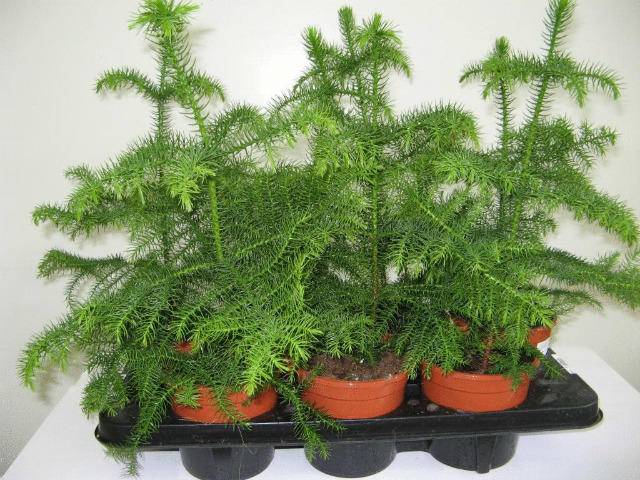

Among the most popular are:
- cypress. The intense light green light and pyramid shape make this indoor flower a welcome addition to your existing home collection. Moreover, the appearance of the cypress, or rather its shape, can be safely adjusted. Interestingly, it is this type of conifers that most often serves as an excellent alternative to a purchased Christmas tree. It reaches an impressive size, so you can independently grow this brainchild, which one day will take its rightful place in your living room for the New Year. The rest of the time, this indoor evergreen tree will transform any interior;
- araucaria. Perhaps one of the most budgetary substitutes for a Christmas tree. A small plant is easy to care for. Araucaria is a tropical herringbone. Its needles are noticeably different from any coniferous tree in softness and velvety. Few people know that araucaria is also a relict plant that existed during the Mesozoic era. A valuable specimen for any indoor garden, isn't it?
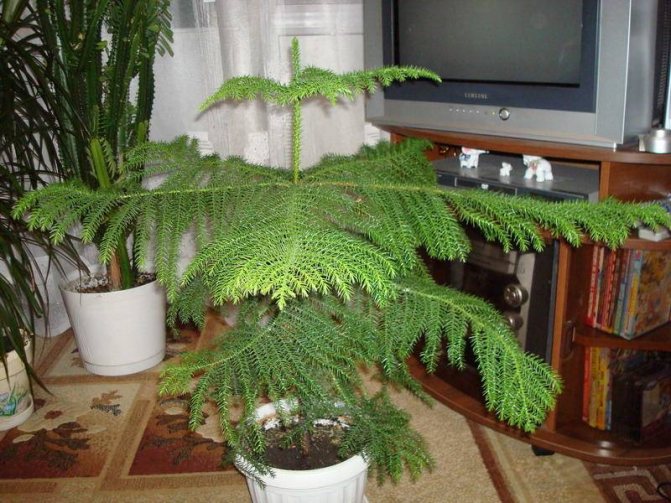

- rosemary. Another small indoor Christmas tree that growers grow not only for decorative purposes. The fact is that rosemary is a popular spice, so those who like to experiment in the kitchen should like the prospect of growing rosemary in their home. But it is very important to get a suitable variety of this indoor flower. Sometimes flower growers prefer Crimean rosemary, but in conditions of relatively dry indoor air, it almost never takes root. A much better option would be a Mediterranean specimen;
- asparagus. The full name of this plant is pinnate asparagus, but among the people it is also called a prostitute. Such a coniferous tree will decorate any windowsill. Its needles have a rich green color, they are fluffy, and the branches are spreading, hence the name. Asparagus must be properly cared for if you want to achieve visible results. And the first mandatory measure is pruning;
- juniper. If you, while on vacation in the Crimea or the Caucasus, suddenly decide to dig up and bring home a small juniper bush, you will hardly be able to grow it at home. It is better for this purpose to purchase an indoor shrub or seeds in a flower shop;
- fir. You can decorate your home most of all with dwarf species of Korean fir; there is a whole variety of them in the modern flower market. Each of the copies has its own characteristics, so you will certainly find something suitable for yourself.
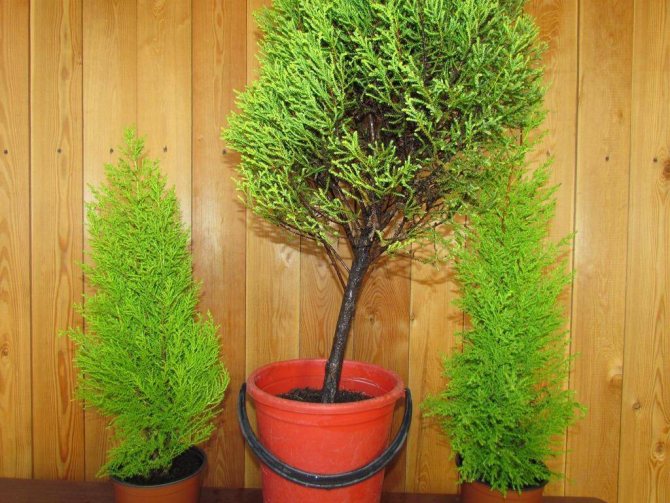

The range of indoor conifers is amazing. Some of them look like a familiar Christmas tree, and there are some very unusual ones. Fortunately, most of the coniferous trees growing in the house have a fresh, enchanting aroma and have a beneficial effect on the well-being and mood of a person. Therefore, if you still have not decided to purchase such a houseplant, think about it now.

